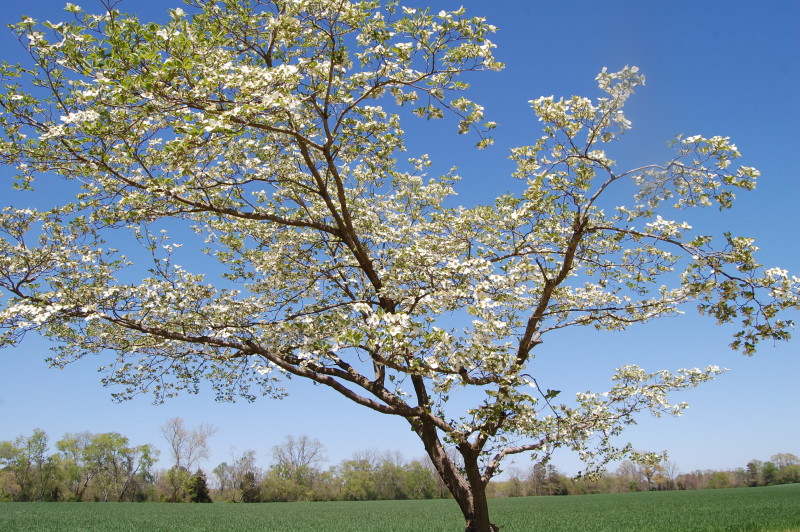LATE SPRING GARDEN CHORES
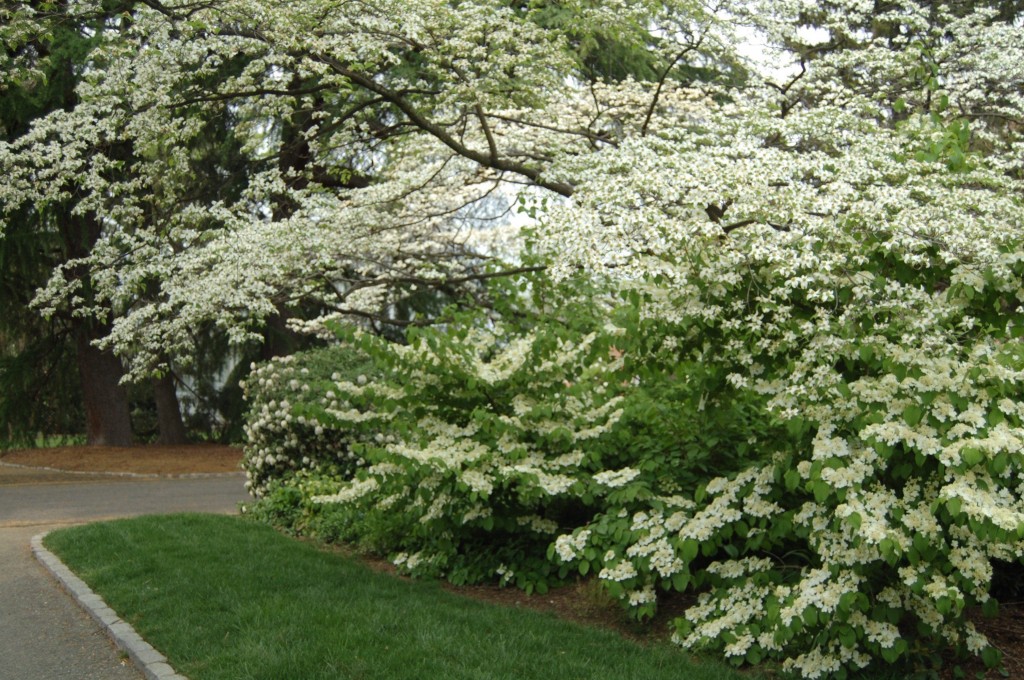
Most spring bulbs are spent, and spring flowering shrubs are shedding their blooms.
Thus, It’s time to:
PRUNE
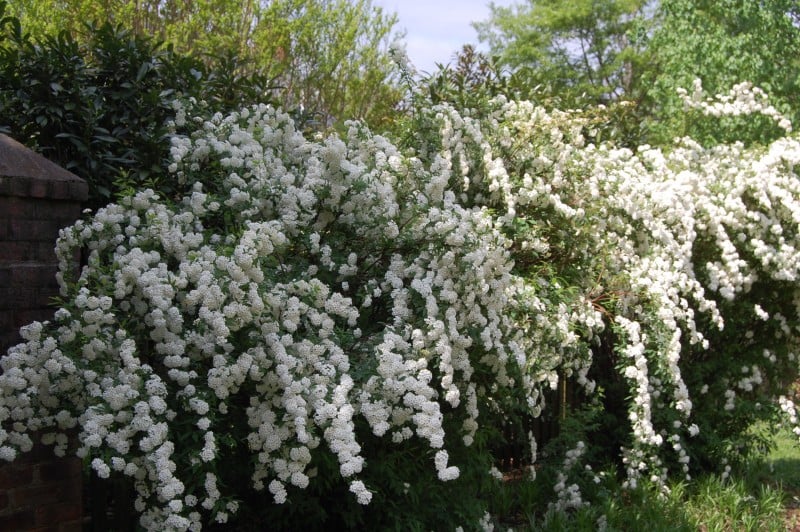
Prune spring-flowering shrubs, if needed.
Most shrubs and trees that flower in spring (like the Vanhouteii Spirea above, Lilac, Azaleas, and Deutzias, to name a few) begin to set their flower buds for next spring within 4 to 6 weeks of blooming. Thus, if you wait to prune the plant after that 4 to 6 week window, you will be cutting off next year’s blooms.
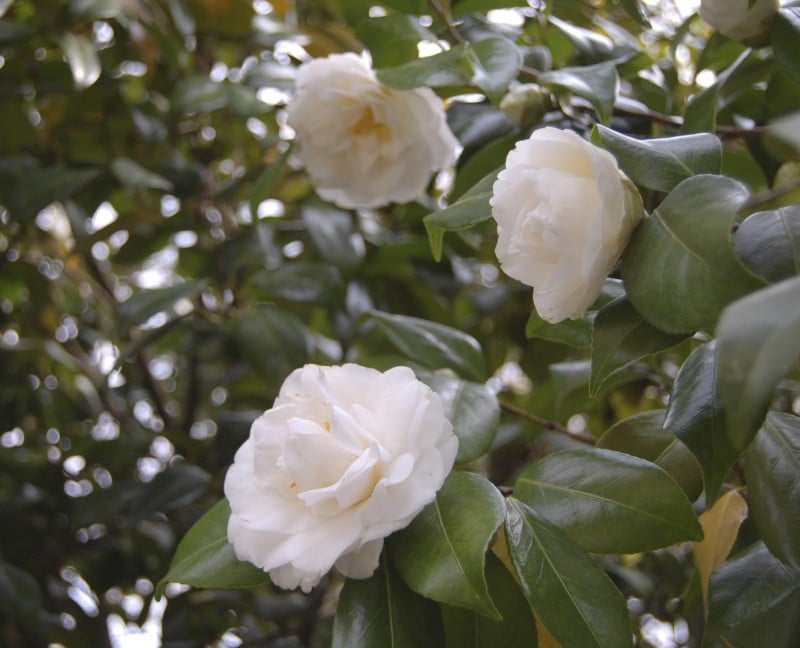
Only prune your shrubs if they need it to control size or to shape the plant (e.g., limb up or espalier) or to remove dead or diseased branches. Use hand pruners, and be sure to take a branch all the way back to a lateral branch (vs. shearing all of the top growth). Camellias (above) need very little pruning, as they have a graceful growing habit. Mock Orange (Philadelphus coronarius, below) is a straggly grower, and can use more help. Mock Oranges are best planted toward the back of a mixed border where they recede after blooming.
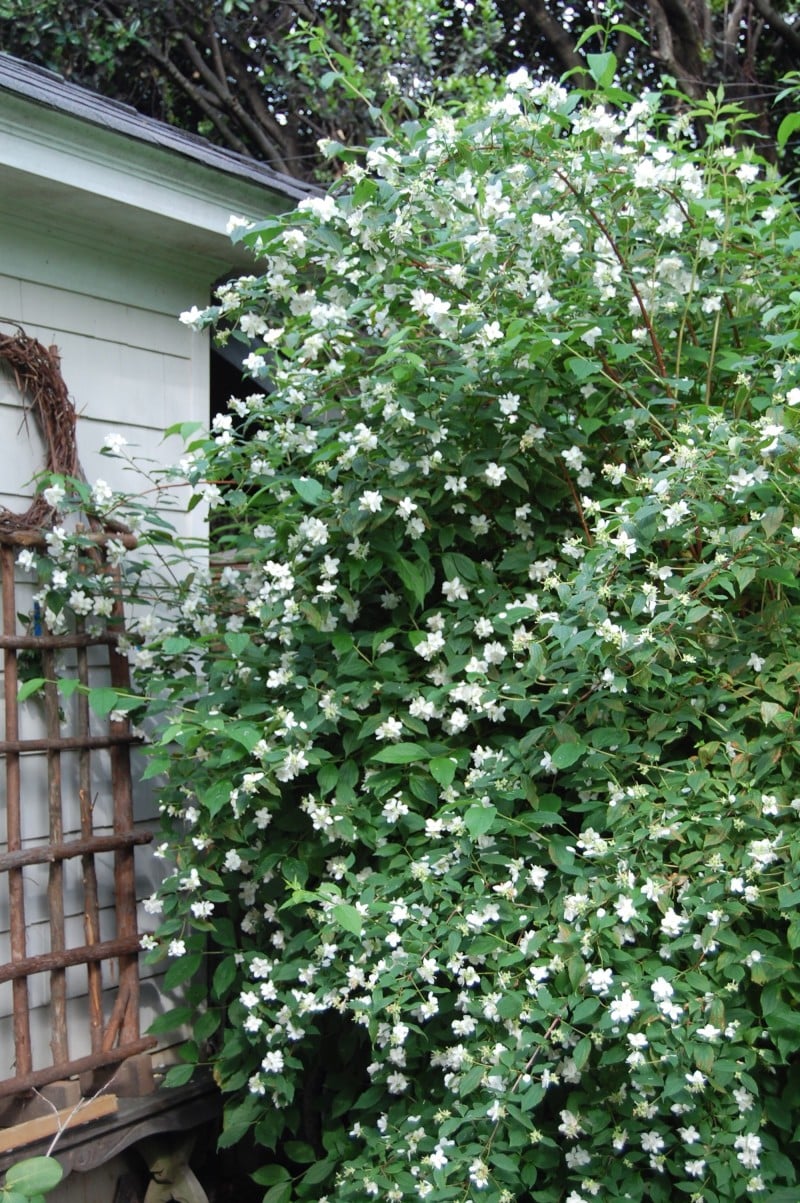
DON’T prune summer flowering shrubs, such as Gardenia, Butterfly Bush (Buddleia davidii), Caryopteris and Beautyberry (Callicarpa).
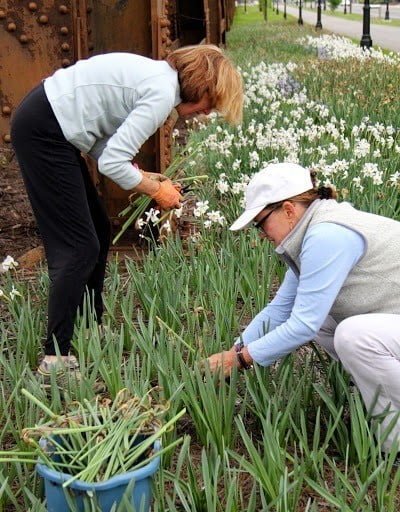
Cut back dying foliage of spring-blooming bulbs, including Daffodils, Tulips and Hyacinth. Capital Trees members Mary Anne Burke and Noni Baruch, above, deadhead the Daffodils planted along Dock Stree in Shockoe Bottom. Spanish Bluebells (beautifully photographed below by Helen Horseley) multiply over the years.
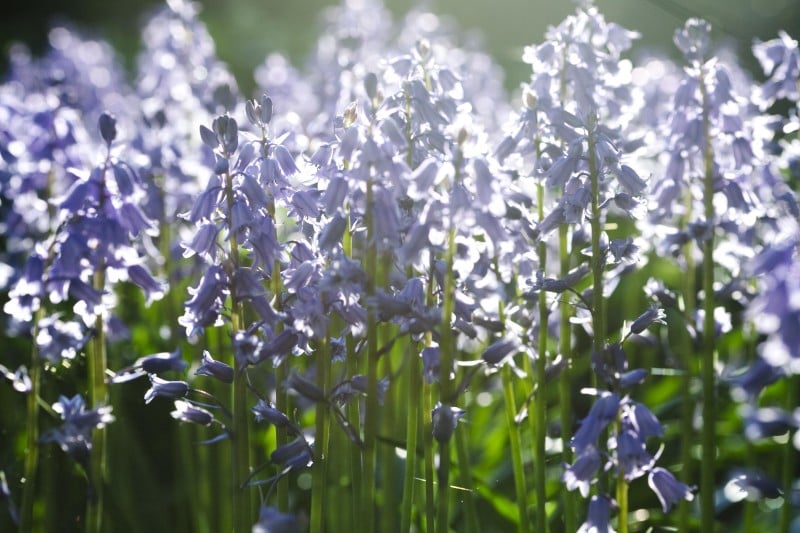
Photo by Helen Horsley
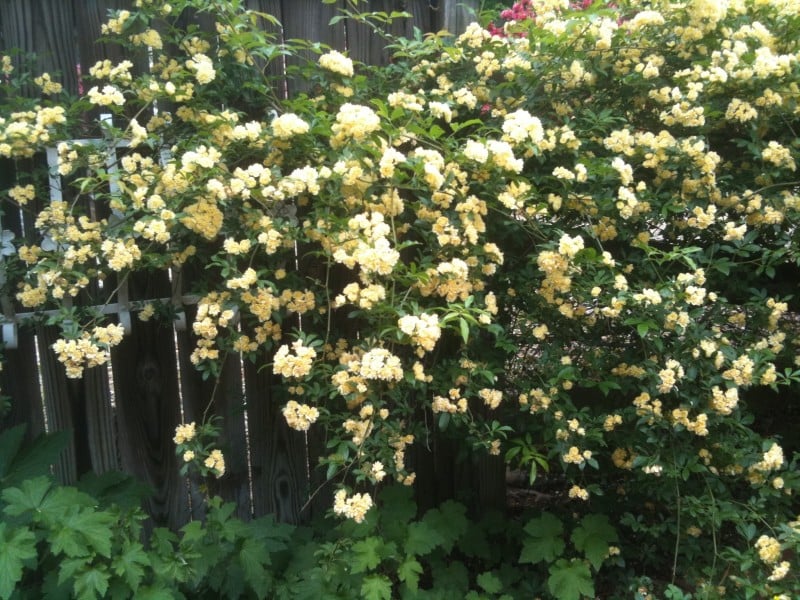
Cut out all rogue branches on your Lady Banks Rose (above). You can tell a rogue branch -or sucker – because it is thicker, straighter, and produces no lateral branches.
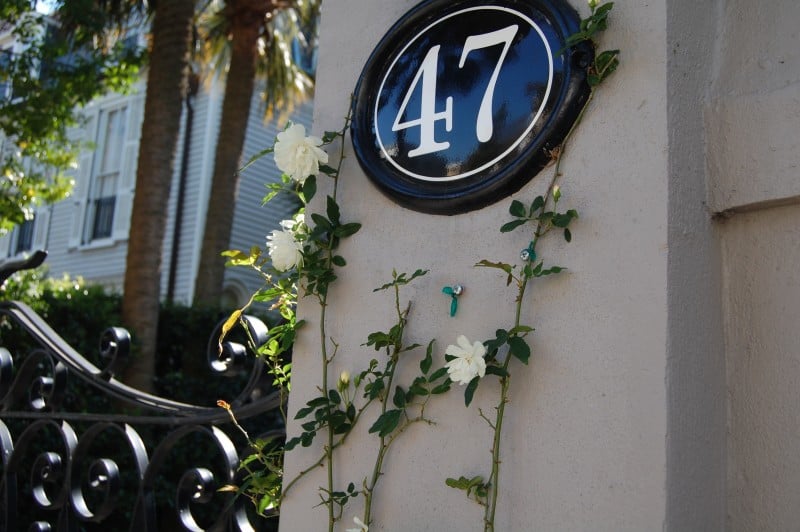
Continue to train other climbing roses. Don’t be shy about removing many older canes to allow for a lighter, more elegant climber, like the one in Charleston, above.
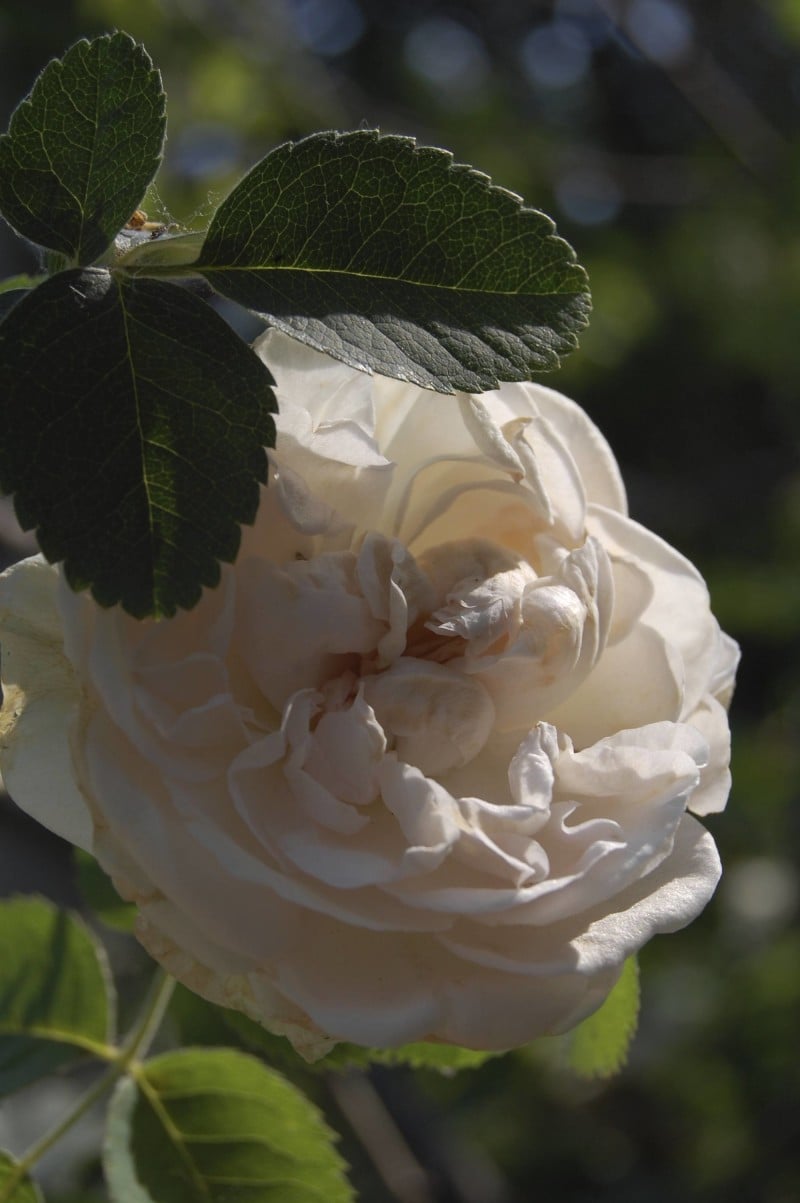
Continue to deadhead repeat-blooming shrub roses. Some of the heritage roses at Hollywood Cemetery, including the Doswell Rose, above, are still blooming. I did a blog post recently about the incredible treasure these roses are at the historic cemetery.
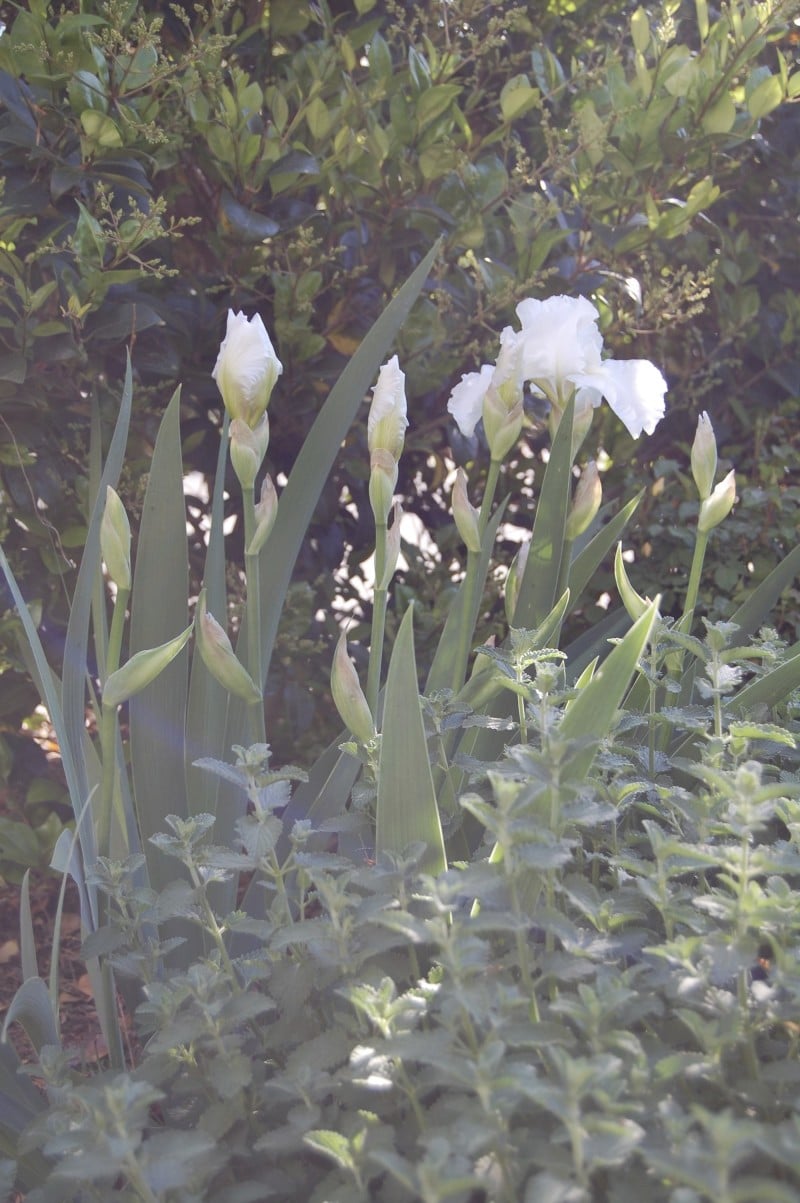
Remove spent flower stalks from perennials, such as Bearded Iris (Iris germanica), above, and Peonies (Paeonia), below. Some Bearded Iris will bloom again in late summer or early fall.
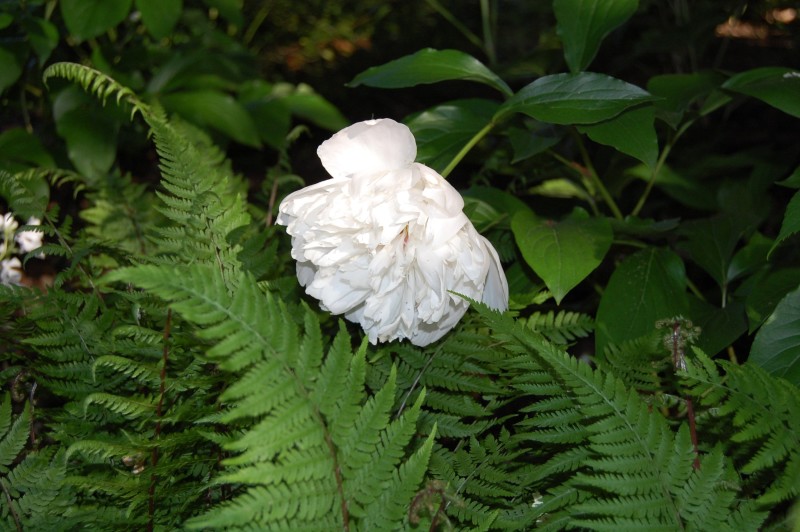
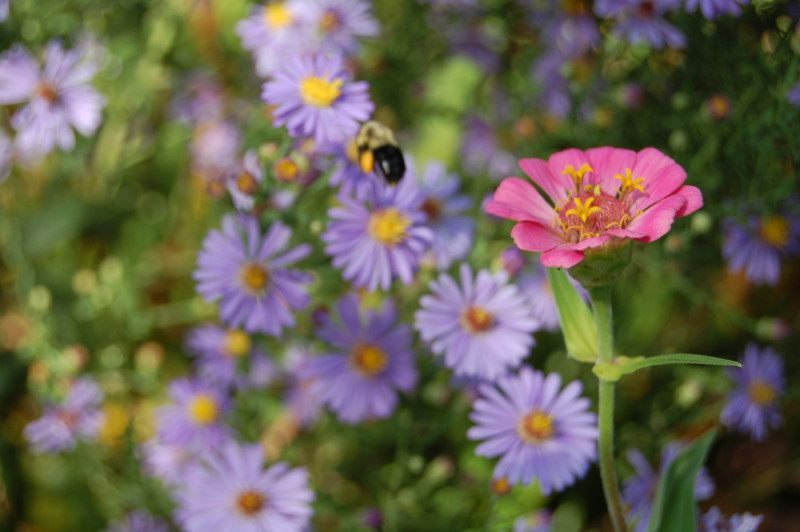
Photo by Melinda Hardy
Pinch back mid to late summer blooming perennials that tend to get leggy, such as Asters (above), Bog Sage, Daisies, Rudbeckia. This will prompt the plants to grow lateral stems and create a bushier plant with more blooms.
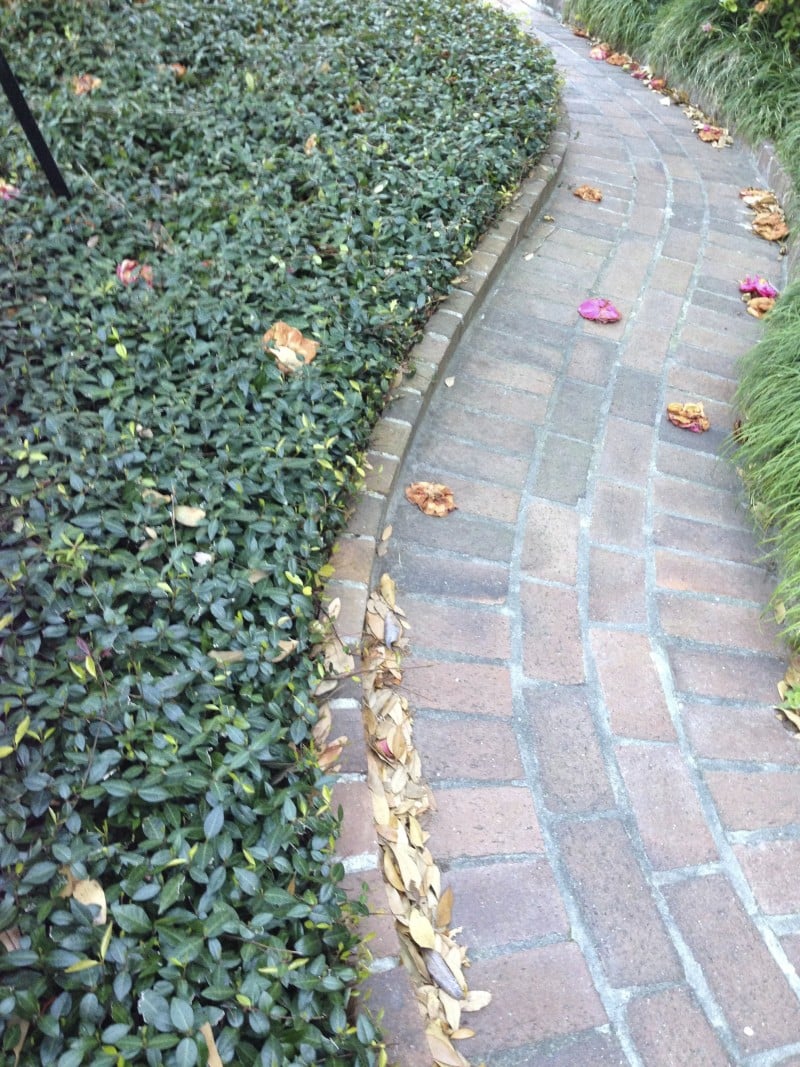
Keep Vinca minor (pictured above) and other aggressive ground covers pruned for a neat appearance.

Cut back to the ground any unproductive Hydrangea branches. An unproductive branch is one that has no or little growth, or is brittle to the touch.

Prune Climbing Hydrangea (Hydrangea petiolaris) after it finishes blooming. Prune other climbers to keep shape.
Climbing Hydrangea is not just for walls — it’s fun to let it scamper across a bed or a low stone wall.
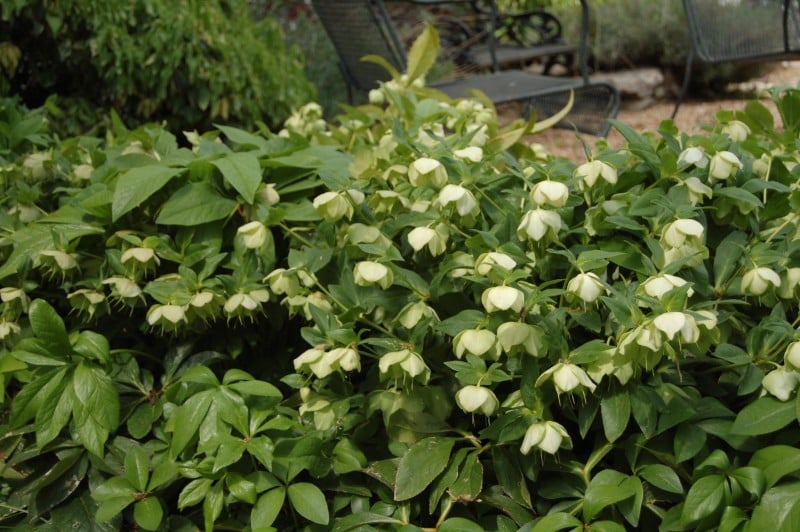
Cut to the ground browning leaves and spent flower stalks of Lenten Rose. Both Lenten Rose (Helleborus orientalis, above) and Stinking Hellebore (Helleborus foetidus, below) will generously self seed if not heavily mulched.
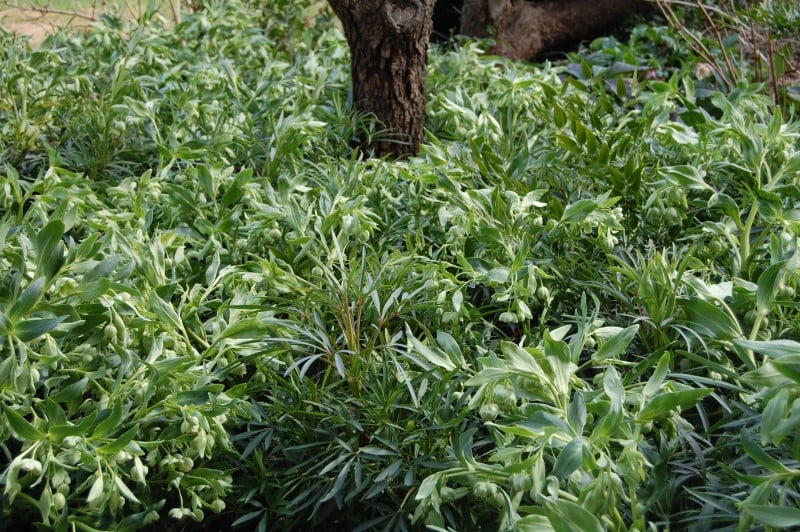
Prune evergreens, if needed.
Evergreen shrubs, such as Hollies, Laurels and Ligustrum, tend to generate uneven growth that can be straggly looking. It is fine to prune these shrubs now to shape them. A couple of caveats: don’t prune Magnolias or other evergreen shrubs blooming now, if you want to enjoy their blooms. Only prune Sasanqua (fall-blooming) Camellias in early spring before they begin forming flower buds.
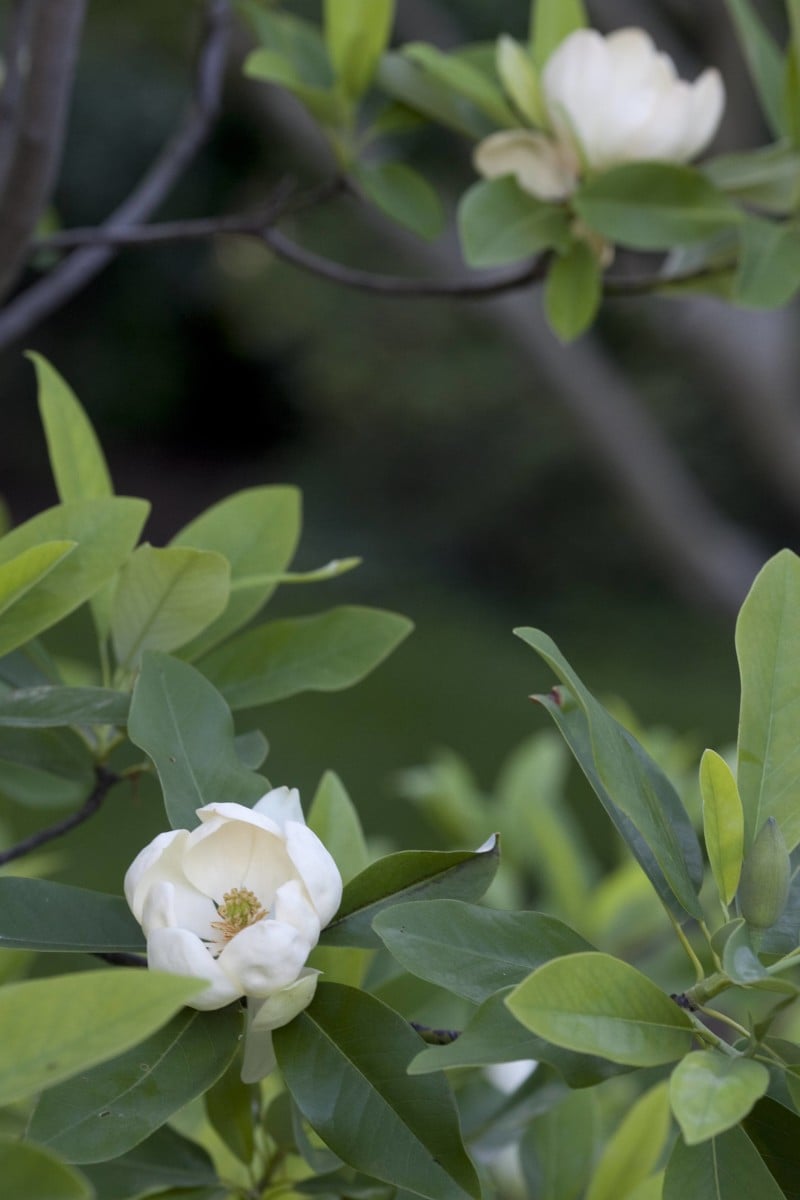
Prune multi-branch trees, such as Sweetbay Magnolias (Magnolia virginiana, above), Japanese Maple (Acer palmatum) and Serviceberry (Amelanchier, spp.) to open up the plant and assist in developing a beautiful shape, by cutting out any volunteer sports and straggly branches. You can also cut suckers and stragglies of Chaste Tree (Vitex agnus-castus), but don’t cut back main branches, as they will be blooming in the next month.
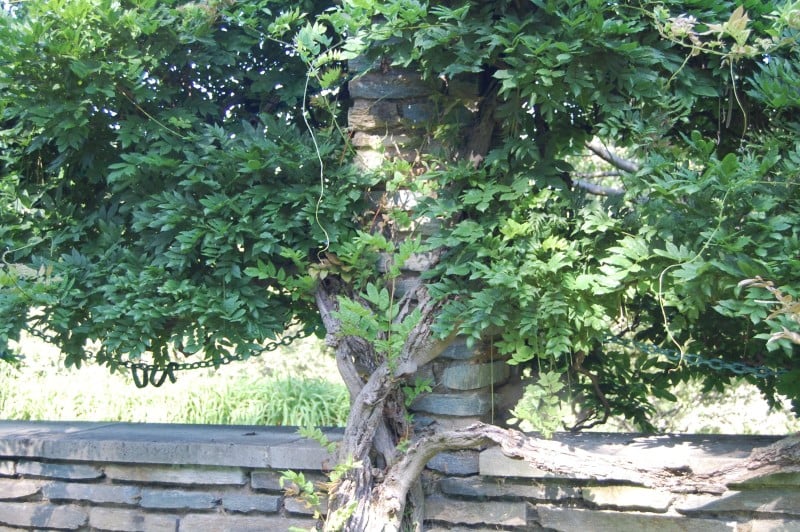
Prune Wisteria before it sets next year’s flower buds.
PLANT

Plant summer vegetables and herbs
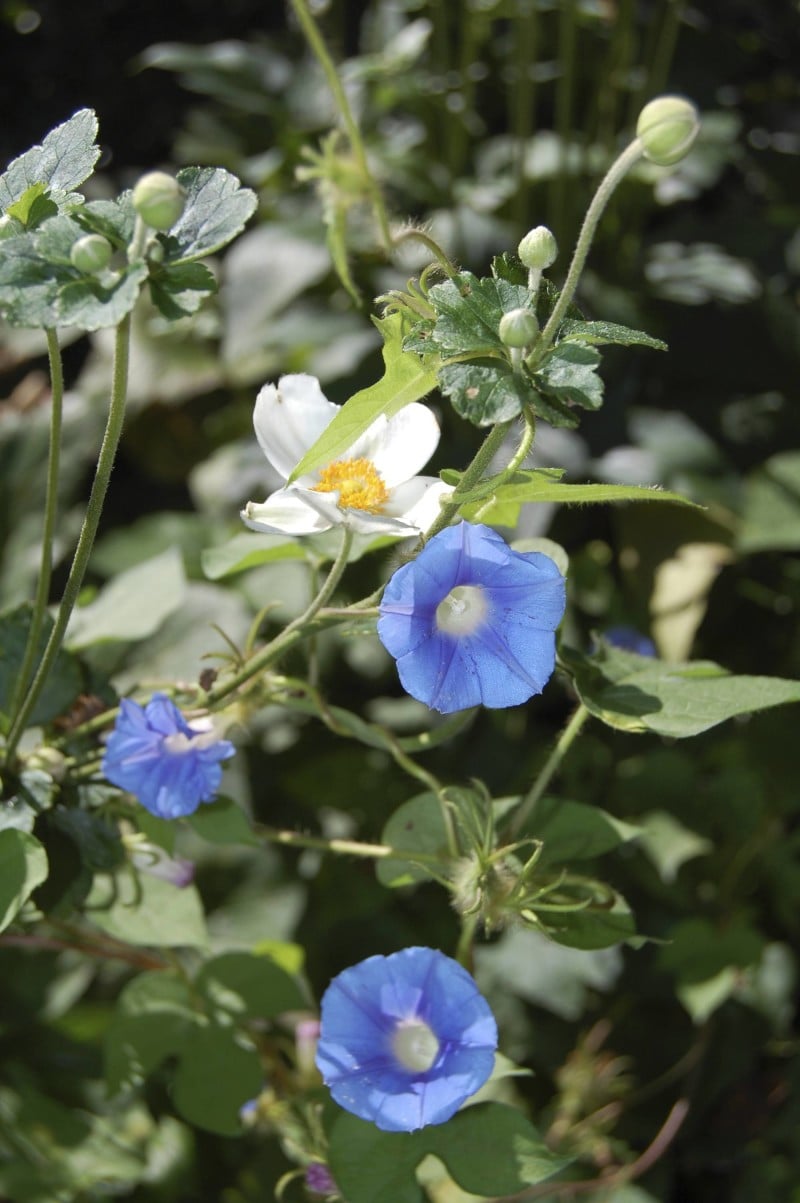
Consider planting Morning Glory seeds for old-fashioned late summer blooms. The vine twines through Japanese Anemone, above.
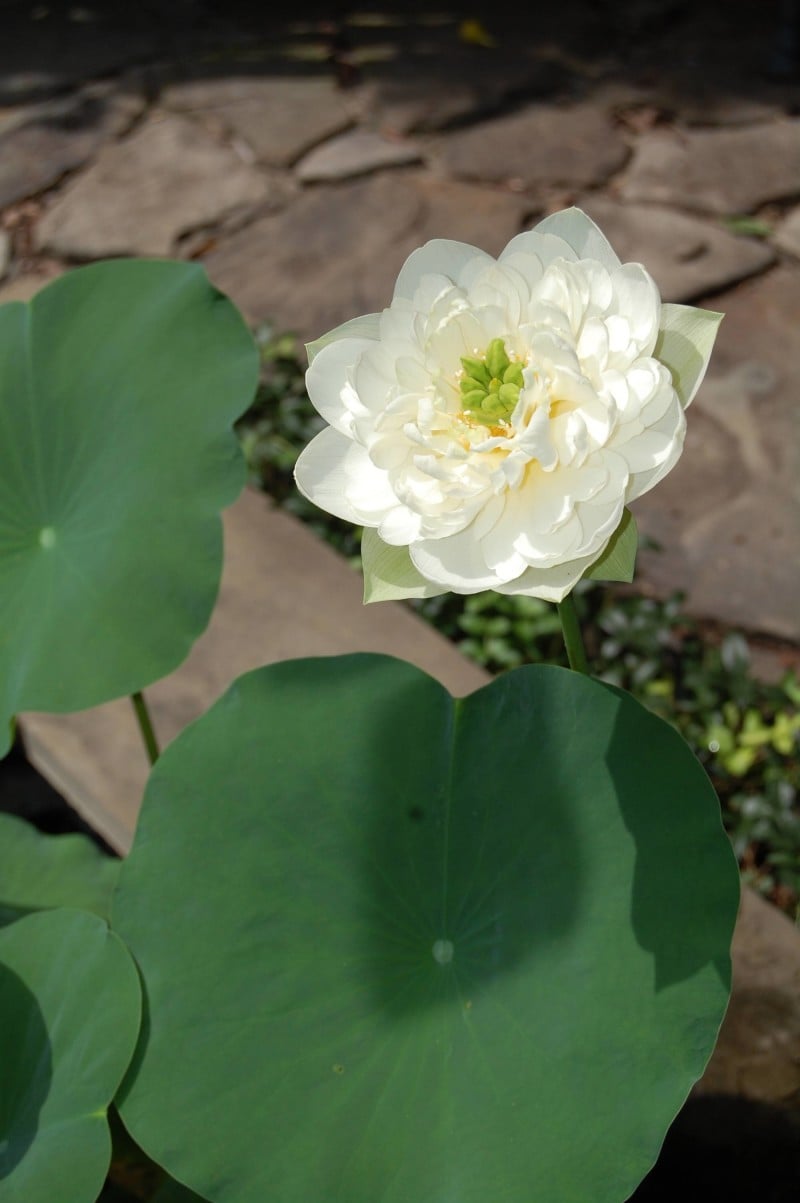
If you have a water garden, consider planting a Lotus (the native Nelumbo lutea).
I’d given mine up for dead and yanked the empty pot (empty except for mud) this spring. As usual, my procrastination (laziness?) saved a life. I went to toss the pot last week and, lo and behold, new Lotus leaves were emerging. Can’t wait to see it bloom like it did last summer, above.
Fill your containers with summer annuals,which will reward you until a hard frost. Be sure to regularly fertilize, as frequent watering depletes the nutrients from the soil. The window box below, on Meeting Street in Charleston, is filled with Begonia and Fern.
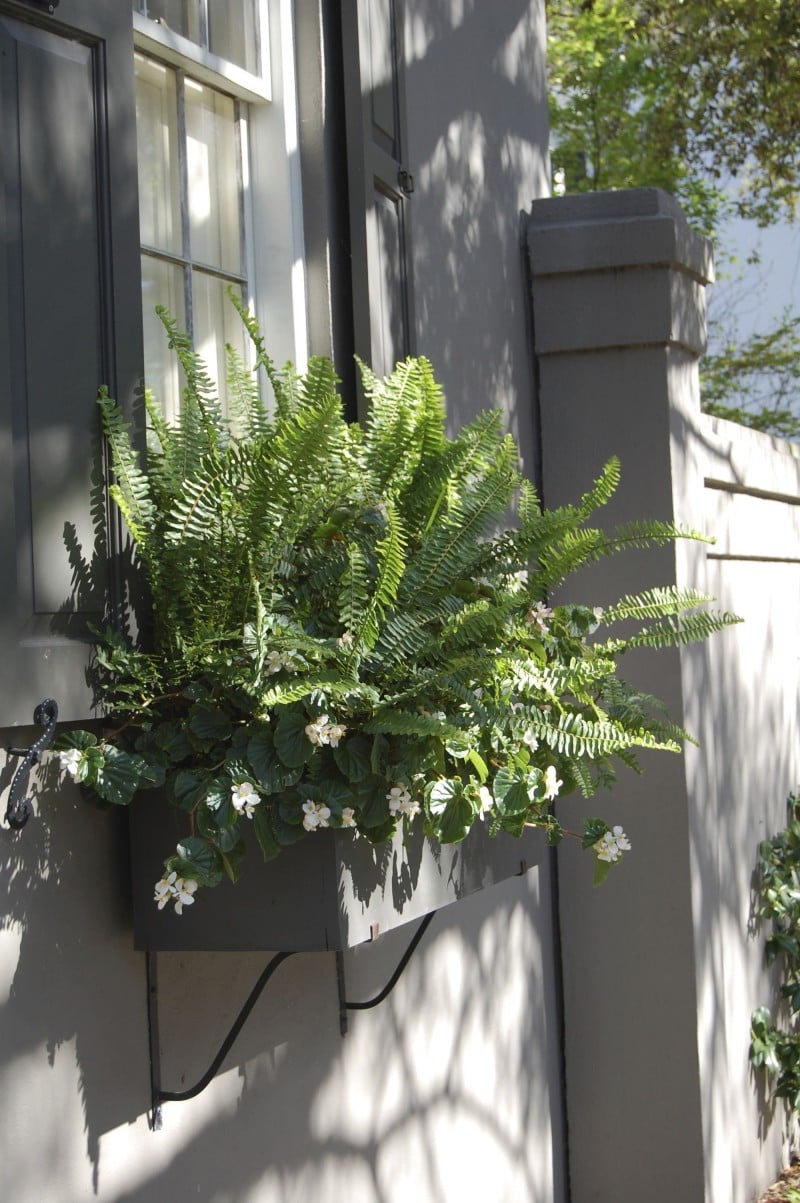
Add annuals to beds to replace plants that have gone dormant. New Orleans gardeners love to plant Caladiums in their otherwise evergreen borders for a shot of contrast. You can also plant masses of Lantana or Plumbago for color all summer. If you are planting in beds containing bulbs or dormant perennials, be sure not to disturb them.

EDGE
Edge your beelines and lawn borders. The person who tends the garden below is on top of it! Maintaining an edge between the lawn and pavement and between the lawn and planting beds helps keep the shape of the beds and prevents weeds from spreading.

WEED!!!!!!!!!!!!
SPRING BLOOMING PLANTS AND THE ARRANGEMENTS THAT LOVE THEM
During Historic Garden Week, gardeners from around the Commonwealth of Virginia cut foliage and flowers from the plants they grow in their gardens to use in arrangements that adorn the houses on the tour. The arrangements not only showcase the talents of many floral artists, they also showcase some of the stellar plants that grow in Virginia. Consider planting a few in your garden.
Here’s just a small sampling of the arrangements created by James River Garden Club members this April, and some of the plants that star in those arrangements:
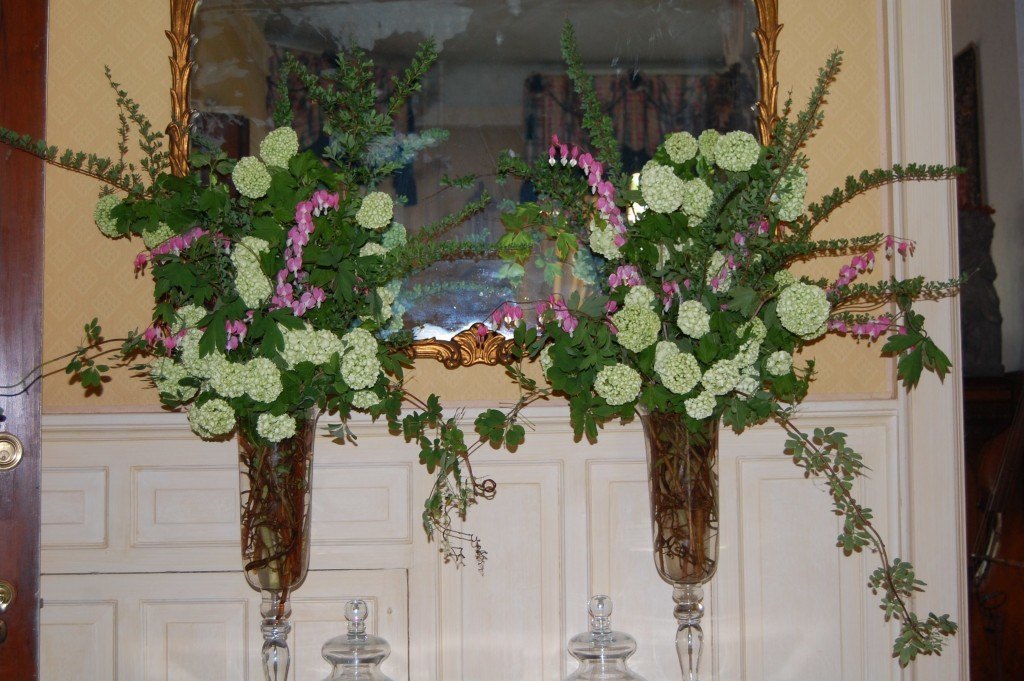
In the double arrangement above, pink Bleeding Heart (Dicentra spectabilis), Guelder Rose — also called Snowball Viburnum — (Viburnum opulus ‘Roseum’), Spirea still in bud, and Akebia vine (Akebia quinata) stand tall.
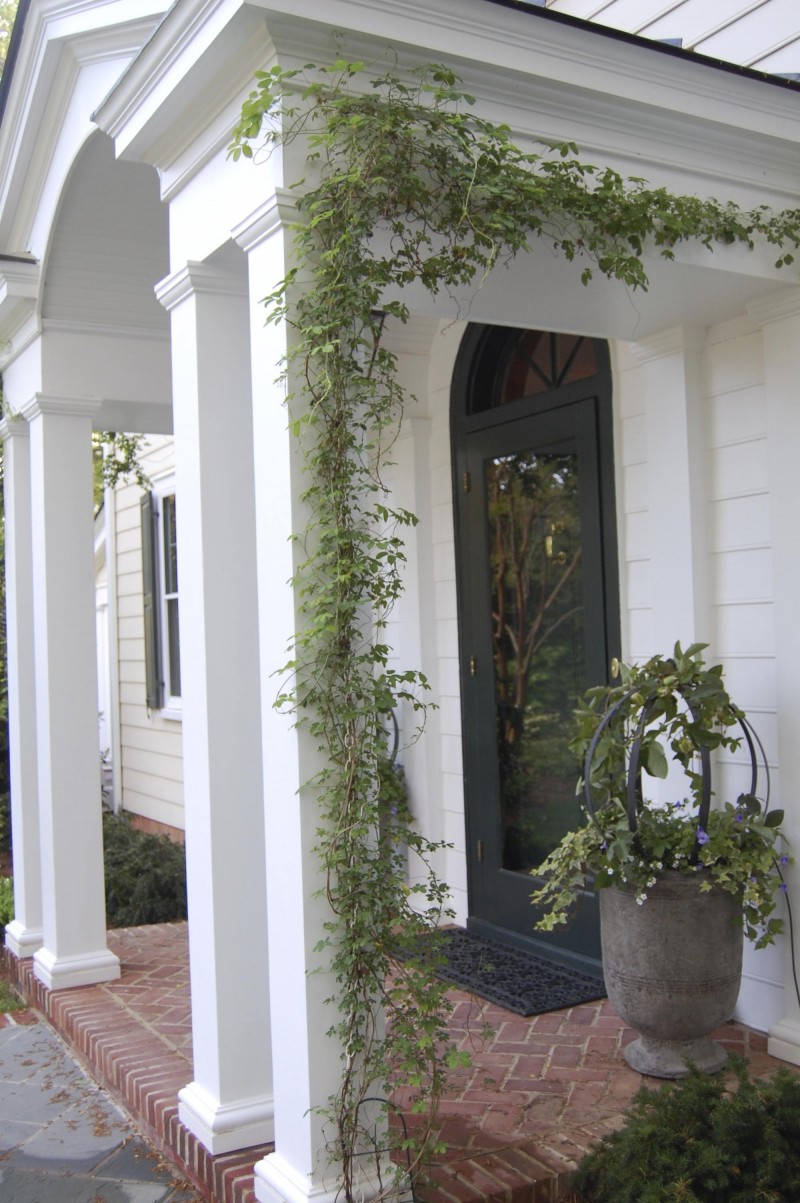
Akebia vine (Akebia quinata)
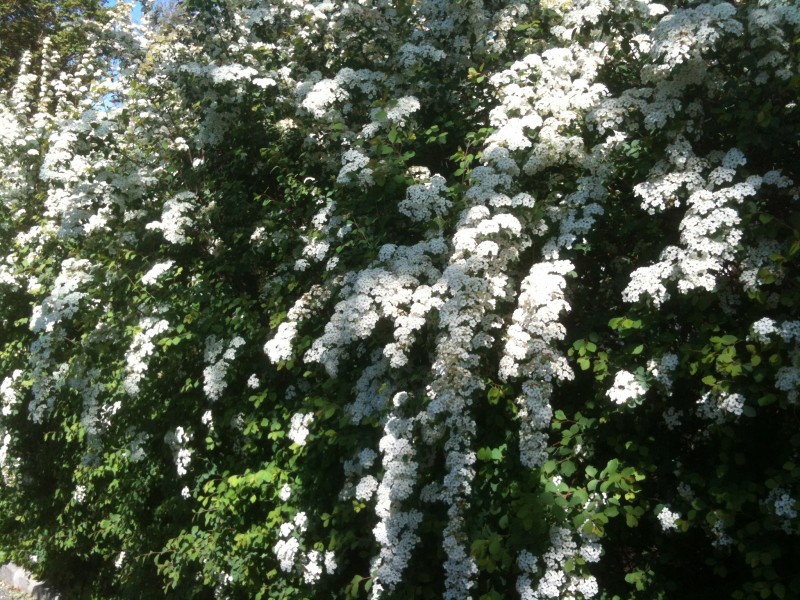
Van Houtte Spirea (Spiraea x van houtteii)
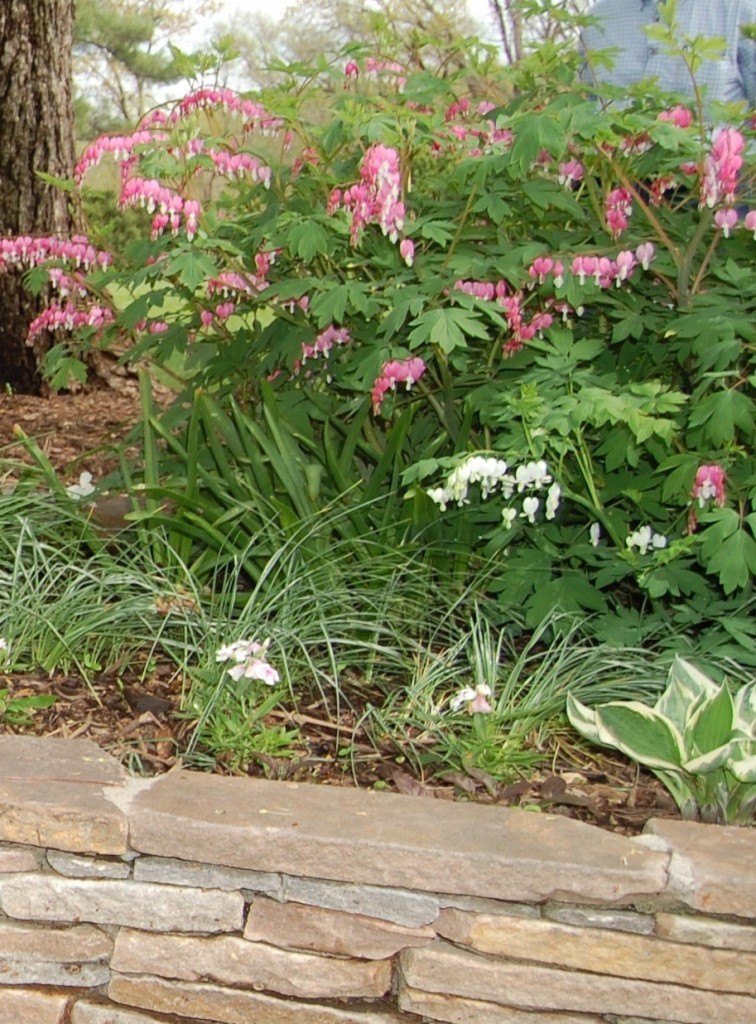
Pink and White Bleeding Heart (Dicentra spectabilis)
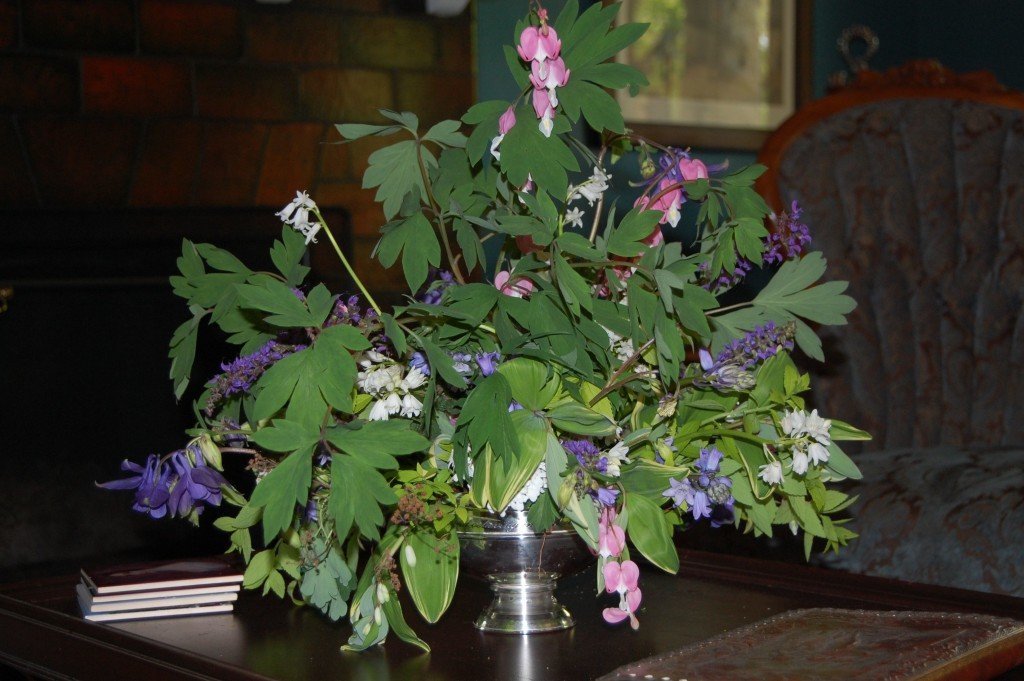
Bleeding Heart is also used in the arrangement above. Columbine (the native Aquilegia canadensis), Spanish Bluebell and its white cousin (Scilla Hyacinthoides), and Variegated Solomon’s Seal (Polygonatum odoratum ‘Variegatum’) casually spill out of a silver bowl.
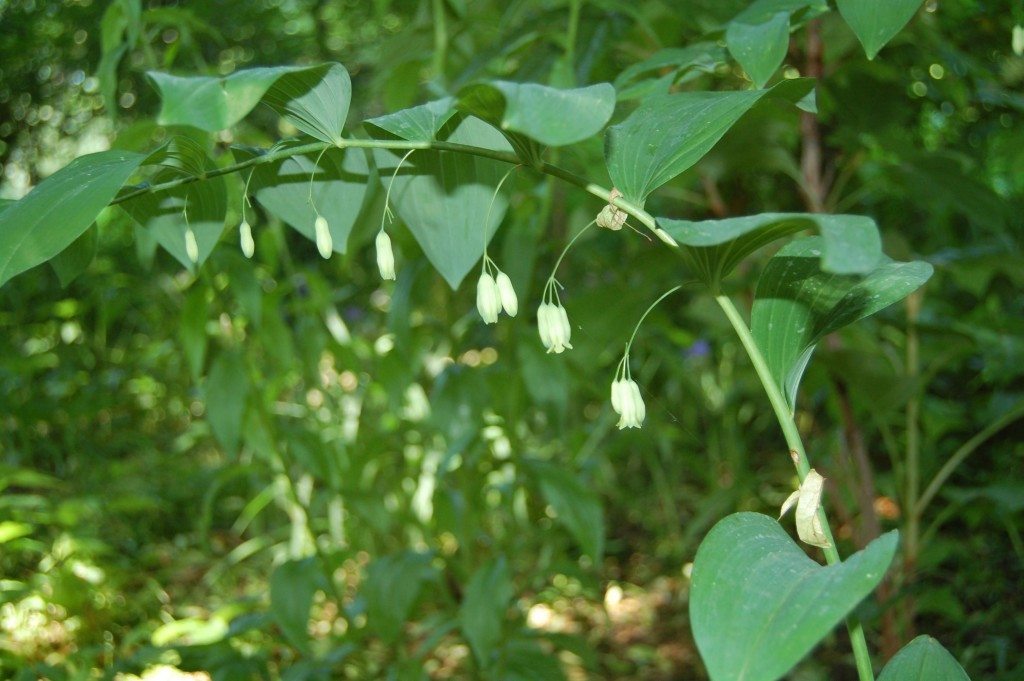
This is the native Solomon’s Seal (Polygonatum biflorum).
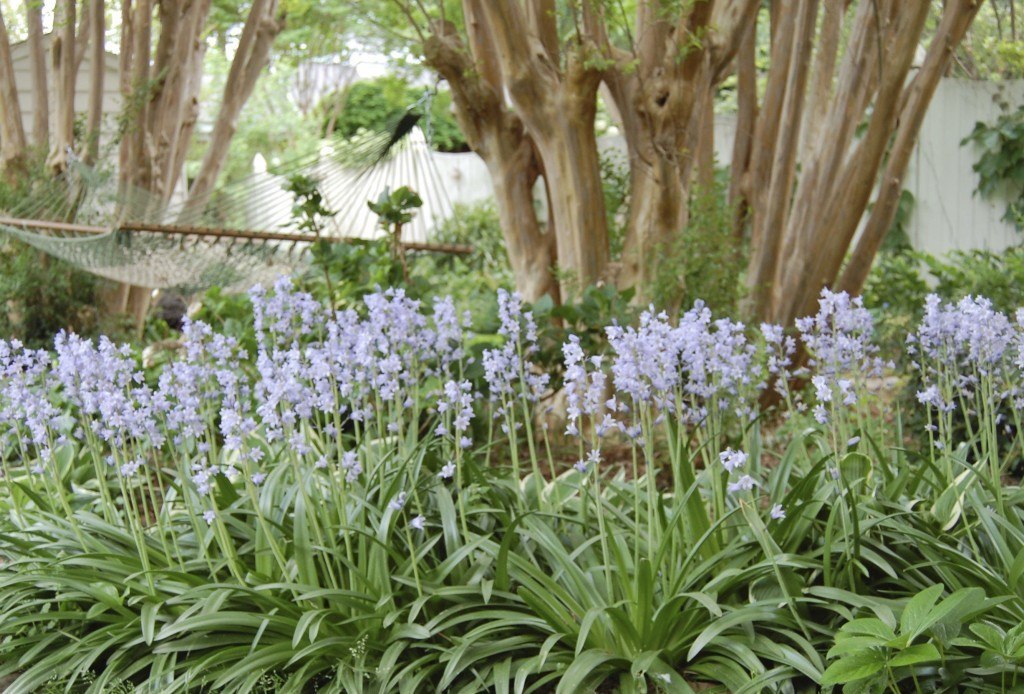
Spanish Bluebells (Hyacinthoides hispanica) are bulbs planted in fall. They bloom in April and May, then go dormant a month later. They spread freely. Photograph by Helen Horsley.
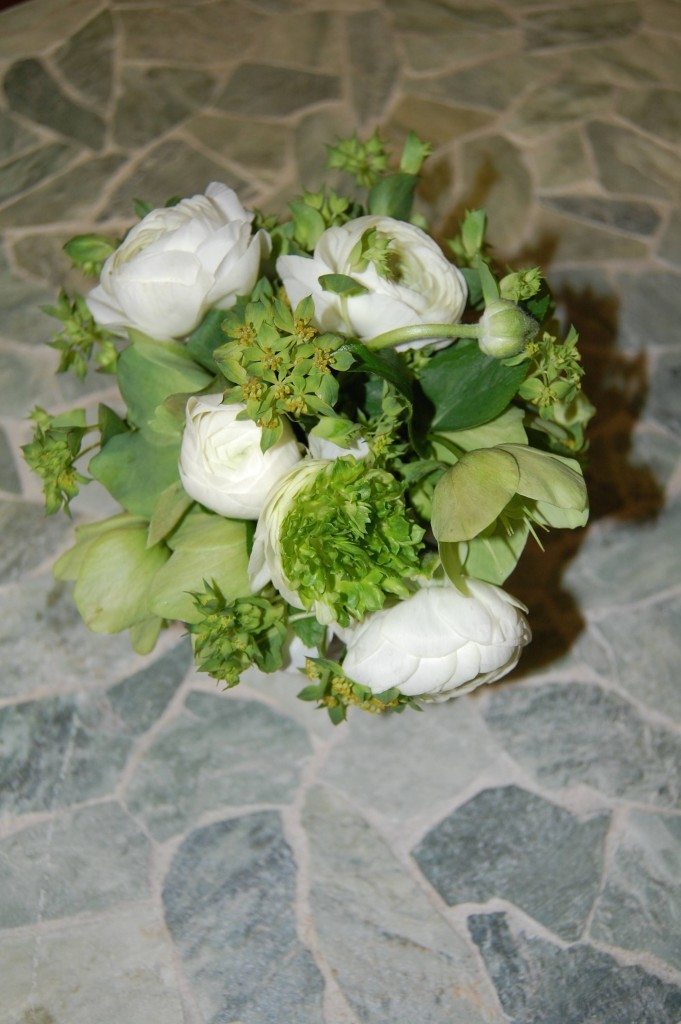
This simple and elegant arrangement contains Ranunculus, Euphorbia and Lenten Rose.
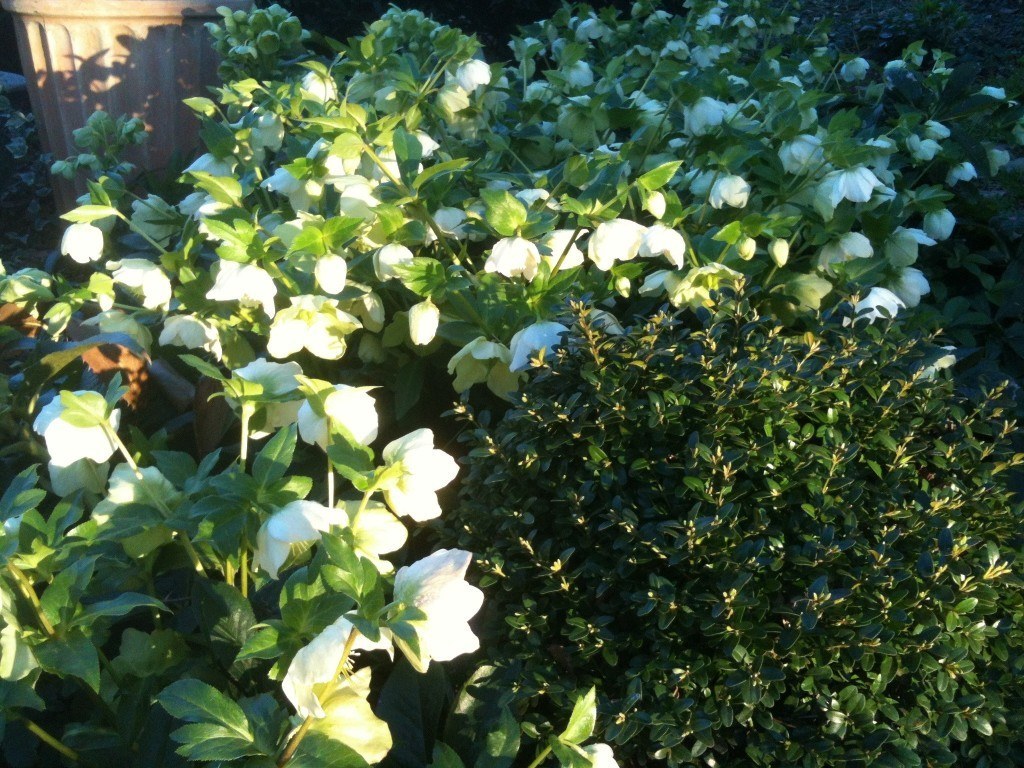
Lenten Rose (Helleborus orientalis)
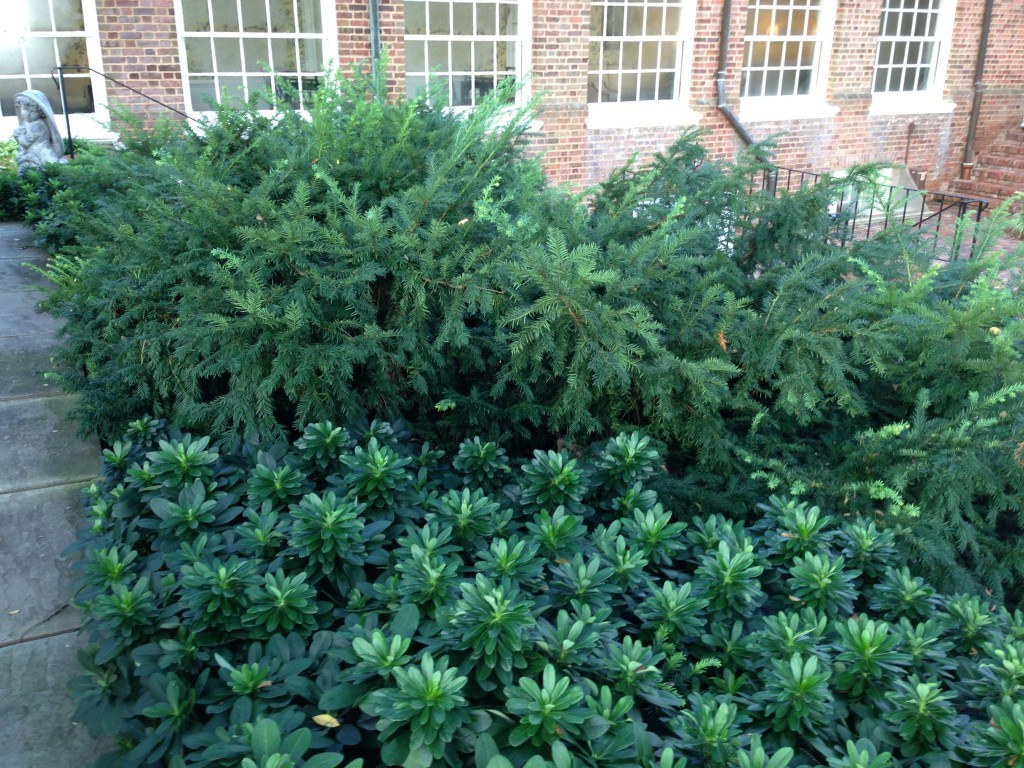
Euphorbia amygdaloides var. robbiae after bloom. It looks a lot like Pachysandra. It is evergreen, thrives in shade, and spreads freely when it’s happy.
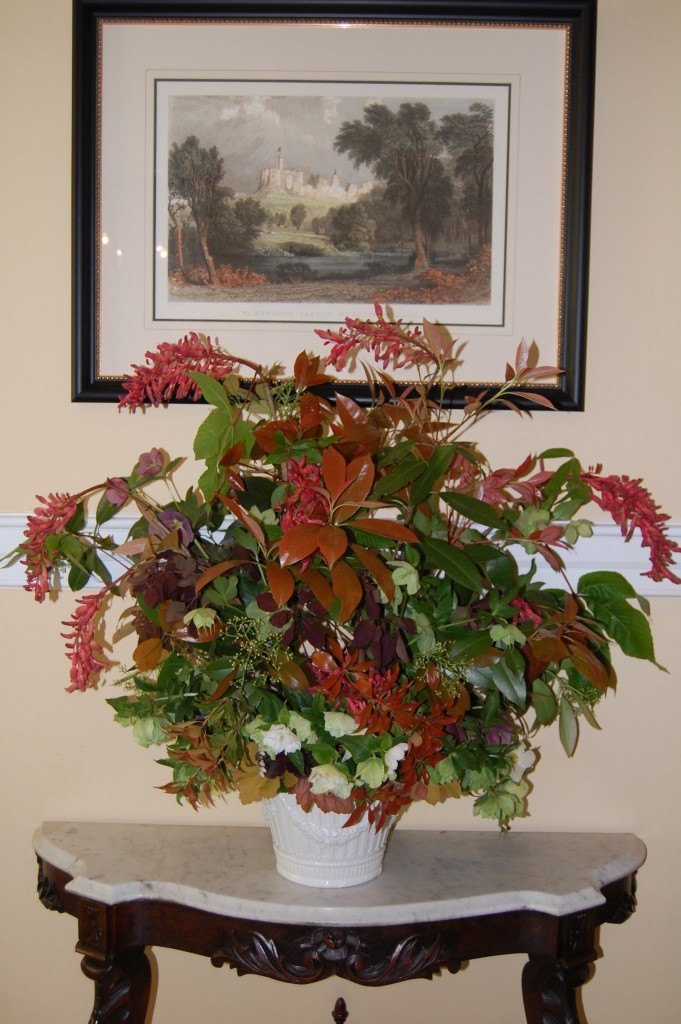
This striking arrangement is all about the foliage. The red-hued foliage of many shrubs, including Red Tips (Photinia x fraseri) and Andromeda (Pieris japonica) highlight the blooms of the Buckeye (Aesculus glabra). The white and pale green blooms of the Lenten Rose complement the reds.
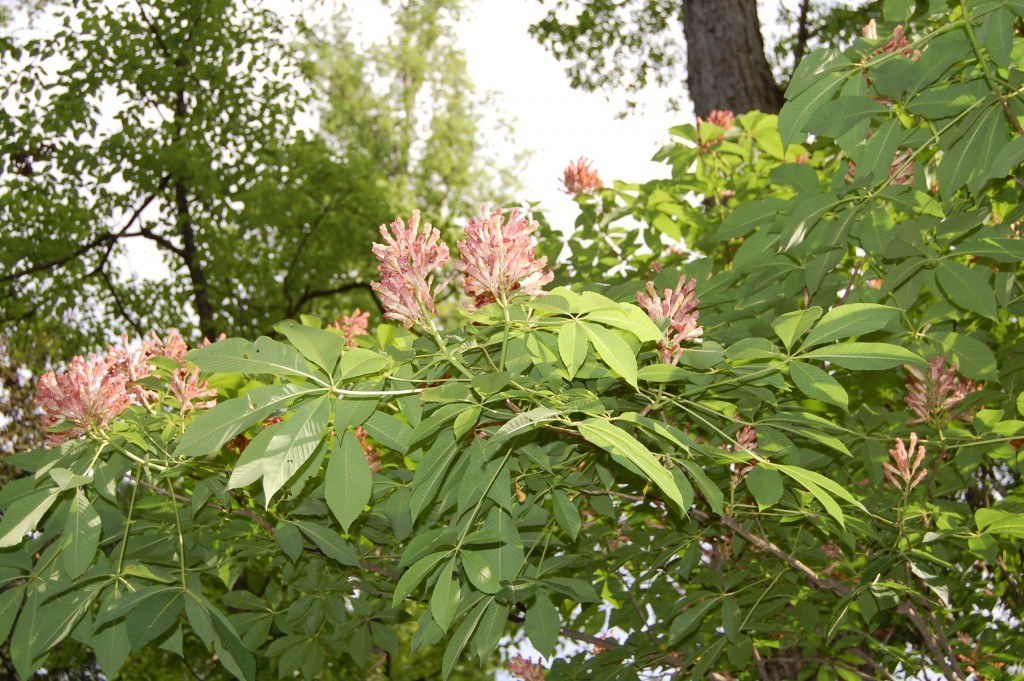
Buckeye (Aesculus glabra)
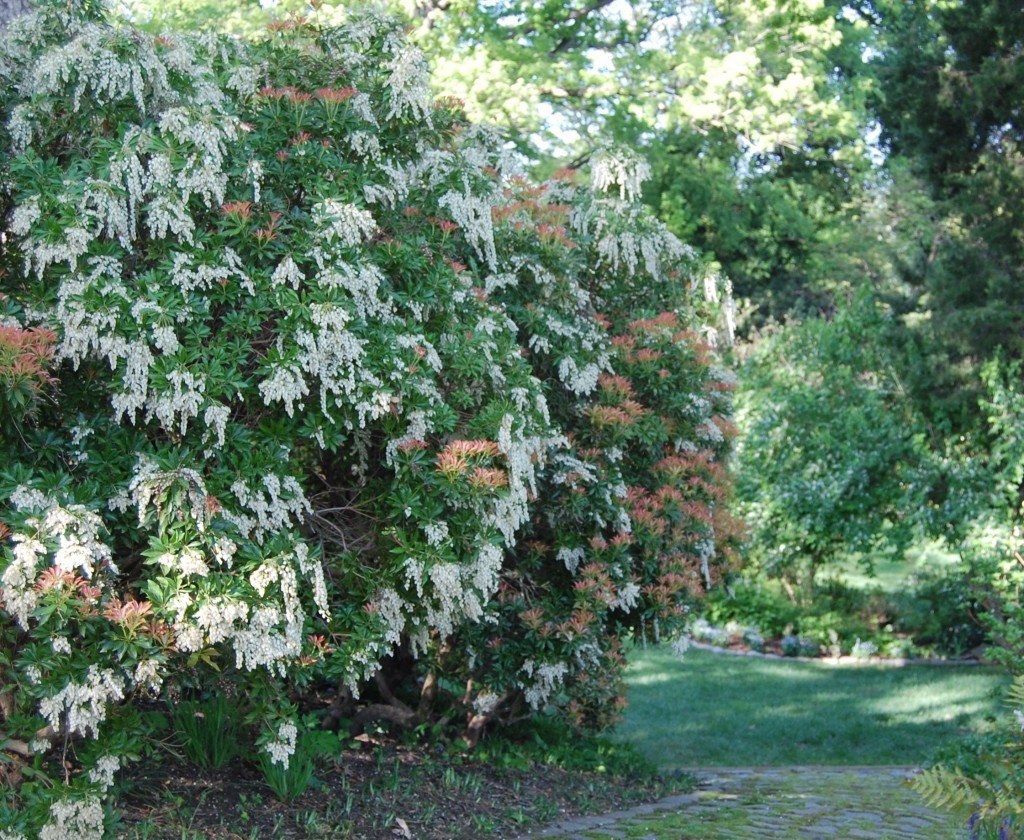
A grove of Andromeda (Pieris japonica) in bloom. The new foliage emerges red, then settles into a nice green.
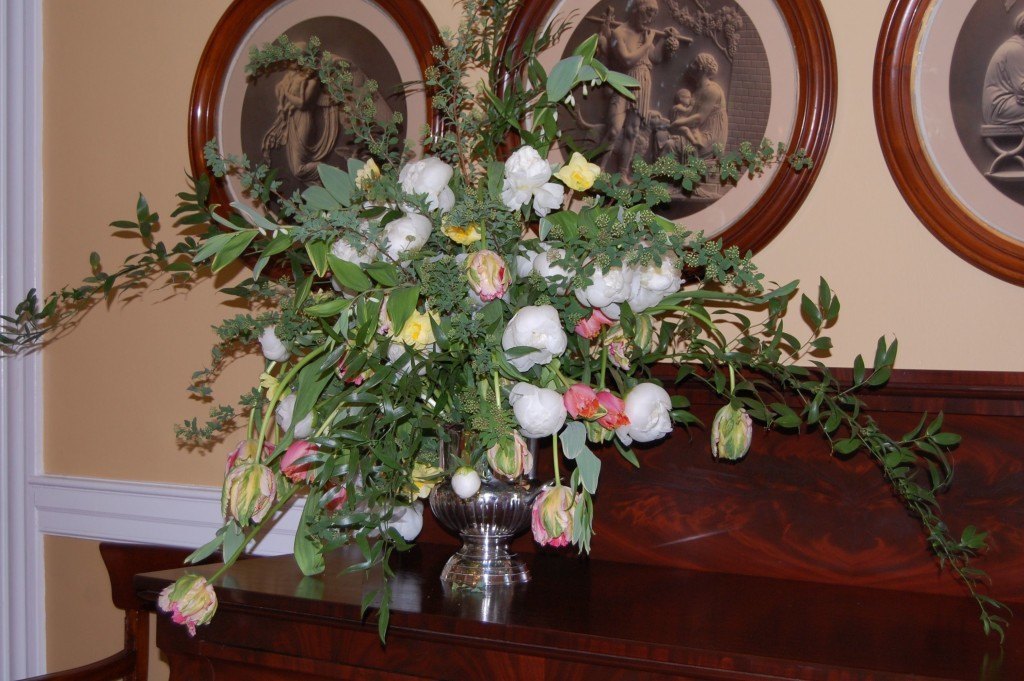 The dramatic arrangement above includes the Spirea and Solomon’s Seal pictured earlier, but the leading ladies here are the Parrot Tulips taking a bow. Poet’s Laurel (Danae racemosa) and Ranunculus anchor the arrangement.
The dramatic arrangement above includes the Spirea and Solomon’s Seal pictured earlier, but the leading ladies here are the Parrot Tulips taking a bow. Poet’s Laurel (Danae racemosa) and Ranunculus anchor the arrangement.

Tulips in varying shades of pink adorn a stone wall in Albemarle County. Deutzia gracilis, in the foreground, is about to pop.
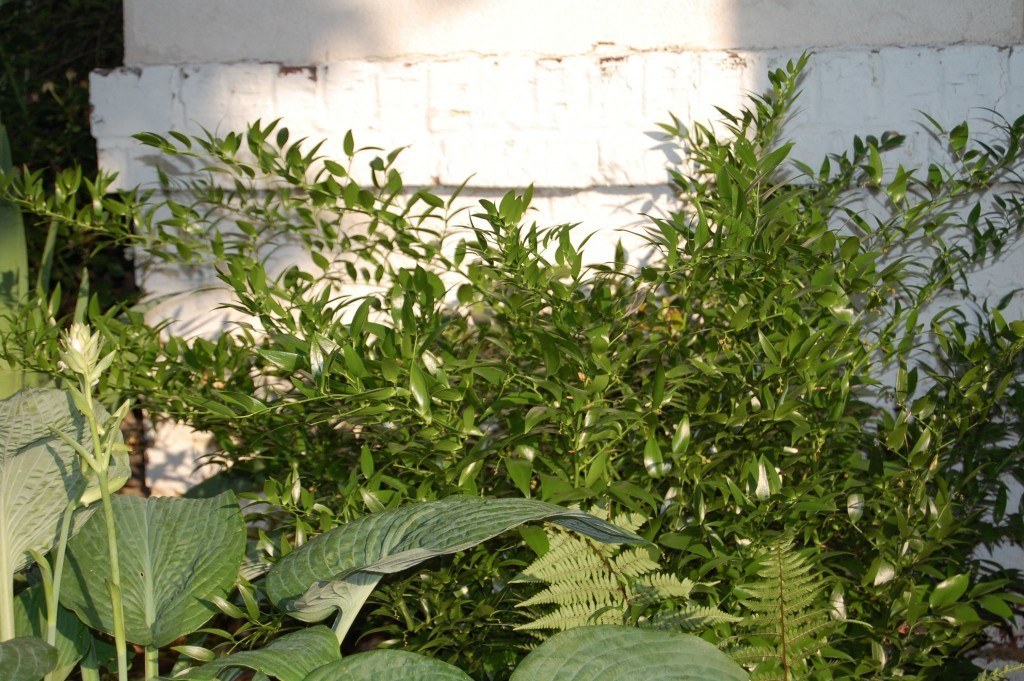
Poet’s Laurel (Danae racemosa) is evergreen, and lasts in a vase of water for a month.
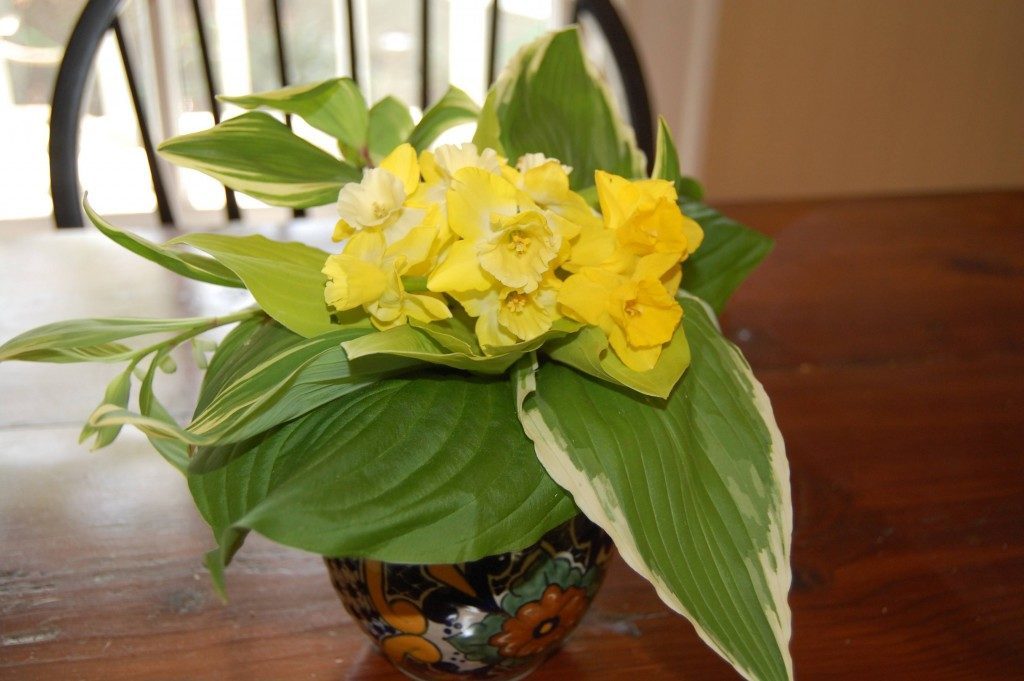
So simple, yet so beautiful. Hosta and Variegated Solomon’s Seal encircle Daffodils.
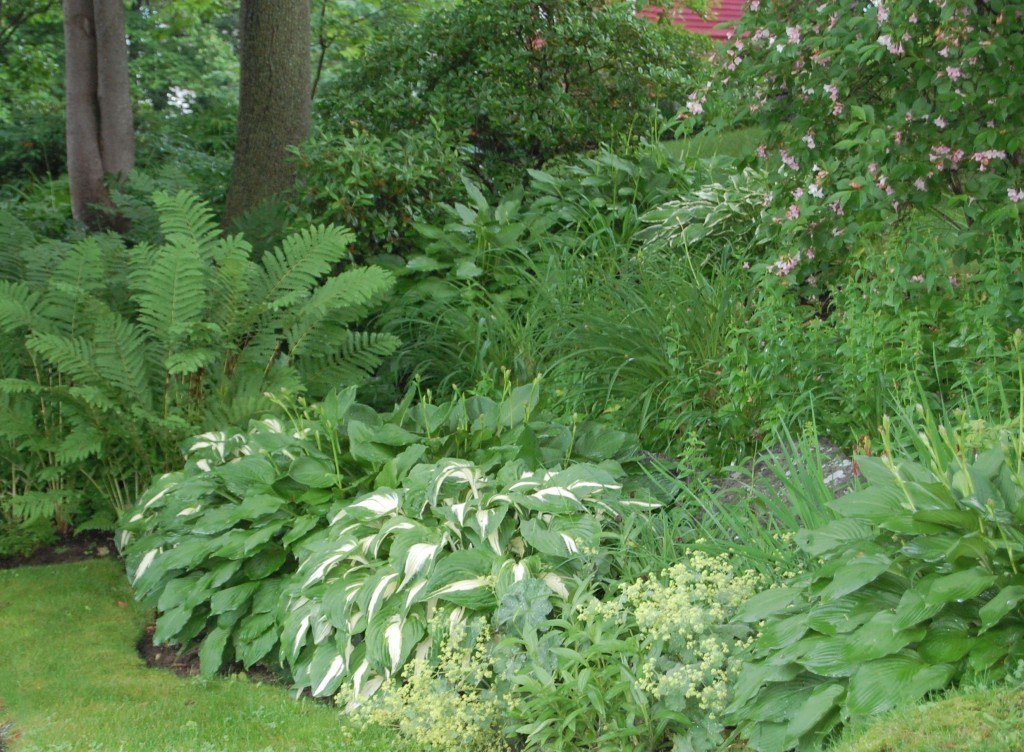
Several varieties of Hosta join ferns and Lady’s Mantle (Alchemilla mollis) in this Maine garden.
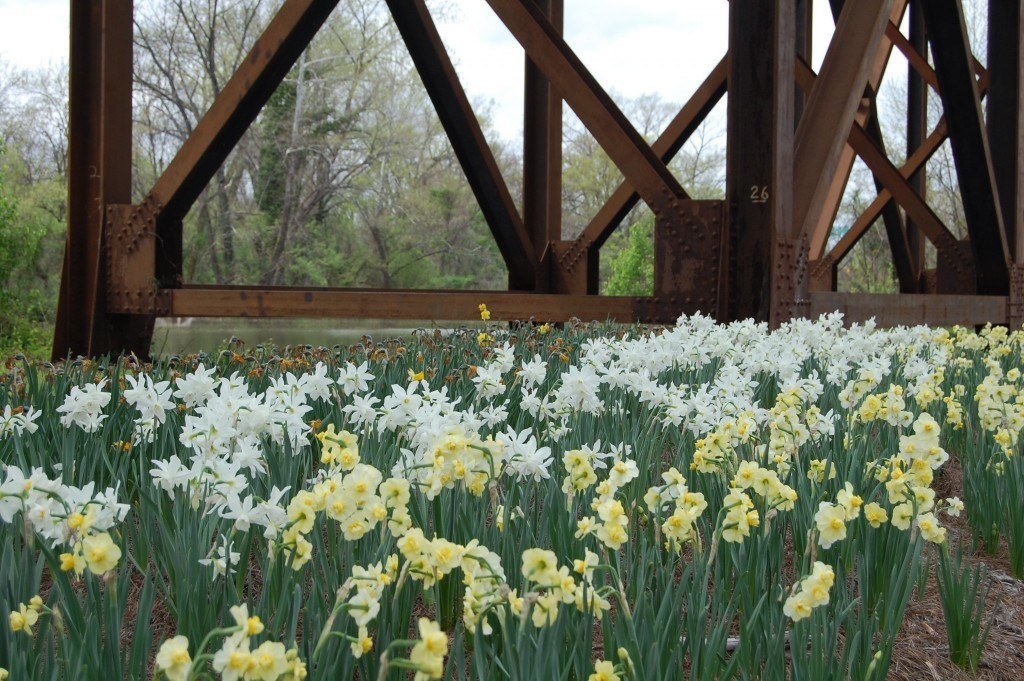
‘Cheerfulness’ and ‘Sir Winston Churchill’ Narcissus bloom along the Capital Trees Low Line in Shockoe Bottom.
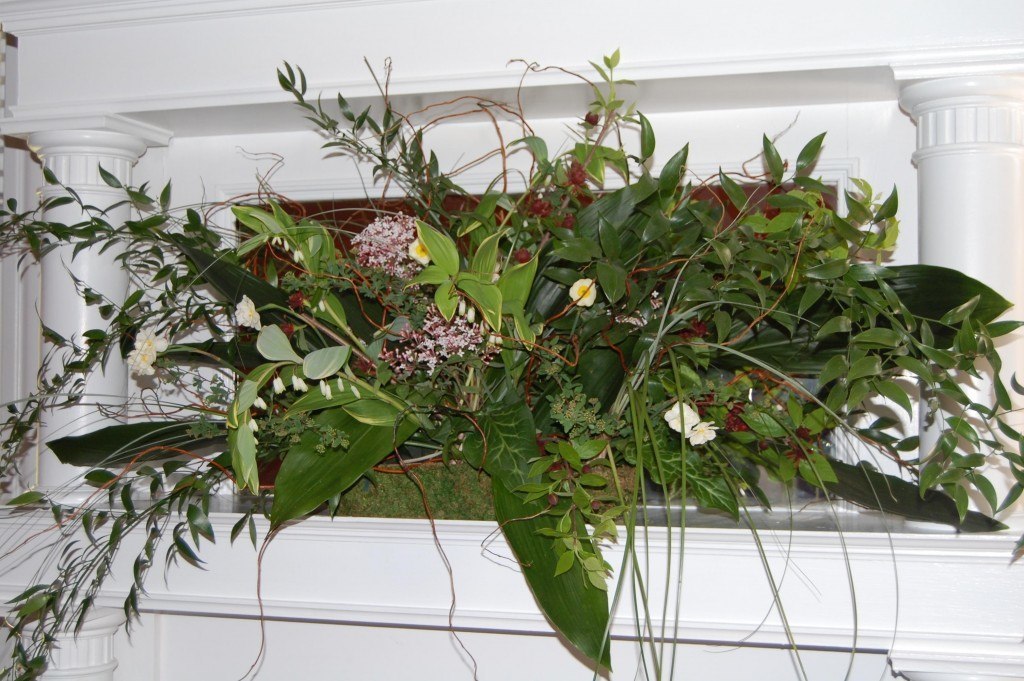 This modern arrangement has an abundance of greenery, including grasses, Poet’s Laurel, Variegated Solomon’s Seal and Arum (Arum italica). Flowers are used sparingly, but to great effect. They include dimuntive daffodil blooms, Lilac (Syringa, genus, I think it is ‘Miss Kim’), and Carolina Allspice (Calycanthus floridus).
This modern arrangement has an abundance of greenery, including grasses, Poet’s Laurel, Variegated Solomon’s Seal and Arum (Arum italica). Flowers are used sparingly, but to great effect. They include dimuntive daffodil blooms, Lilac (Syringa, genus, I think it is ‘Miss Kim’), and Carolina Allspice (Calycanthus floridus).
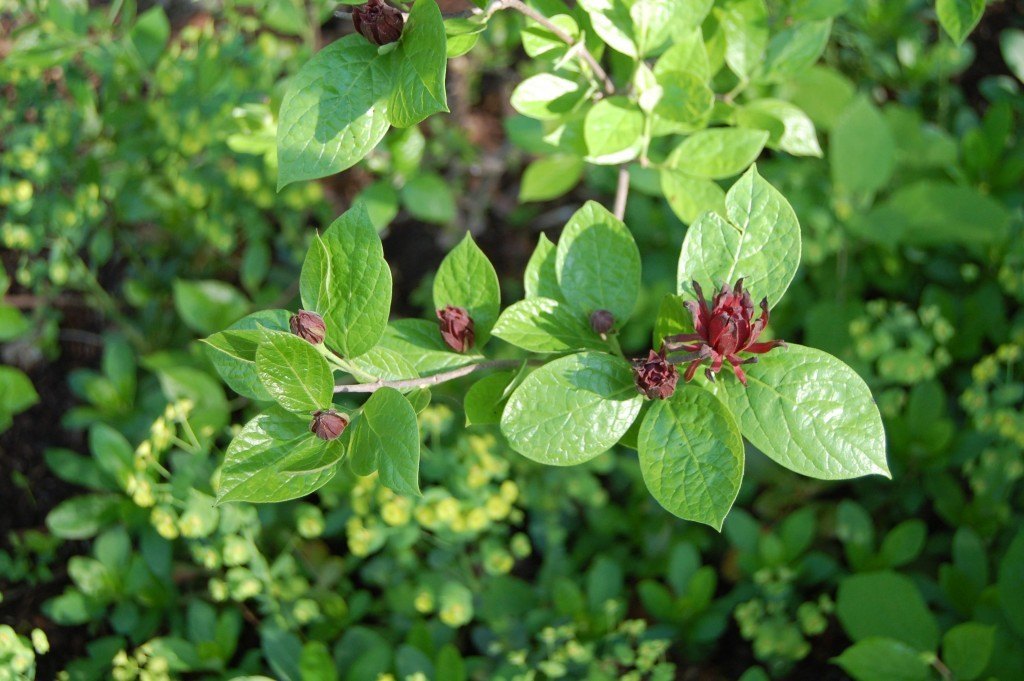
The native Carolina Allspice (Calycanthus floridus)
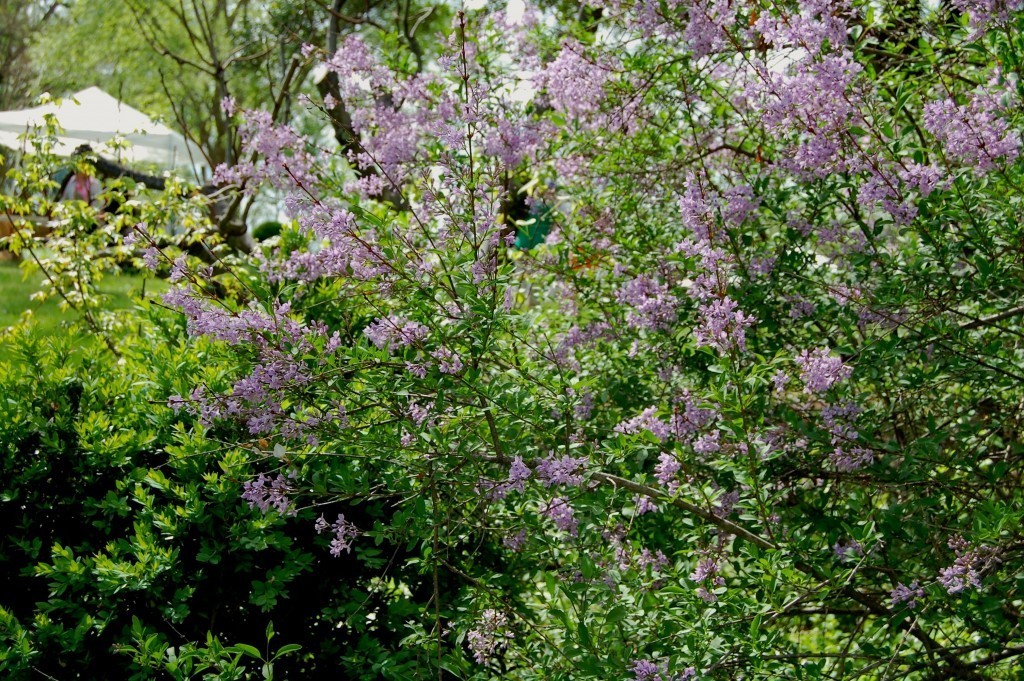
Lilac (Syringa vulgaris)
 The mantle arrangement above is a feast of textures and contrasting hues, with Photinia, Boxwood, Variegated Euonymus, Spanish Bluebells, Lenten Rose, Pachysandra and Native Azalea. Photo by Betsy Trow.
The mantle arrangement above is a feast of textures and contrasting hues, with Photinia, Boxwood, Variegated Euonymus, Spanish Bluebells, Lenten Rose, Pachysandra and Native Azalea. Photo by Betsy Trow.
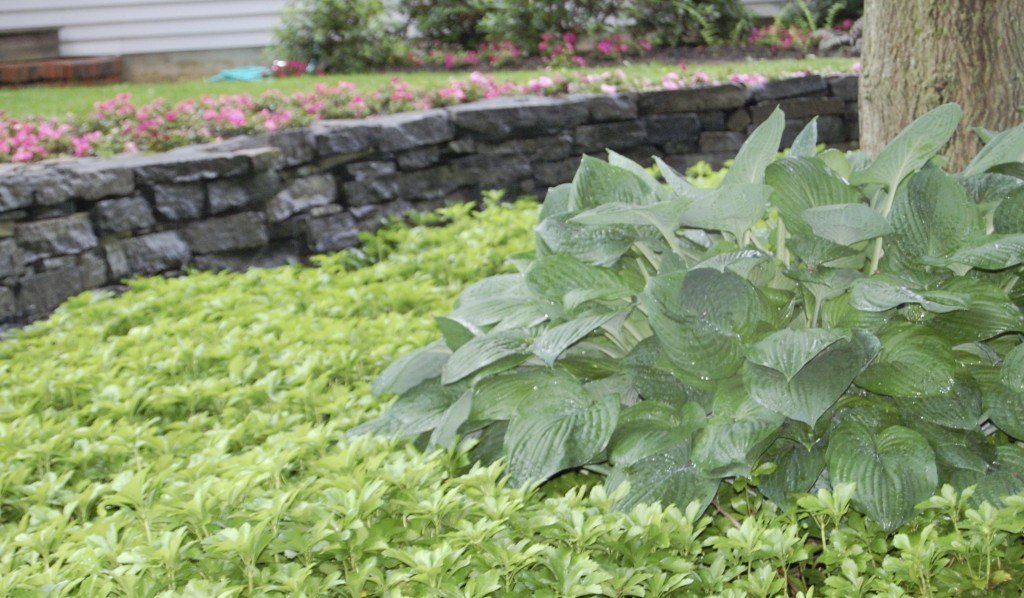
Pachysandra (Pachysandra terminalis) is a great evergreen ground cover that tolerates tree roots.
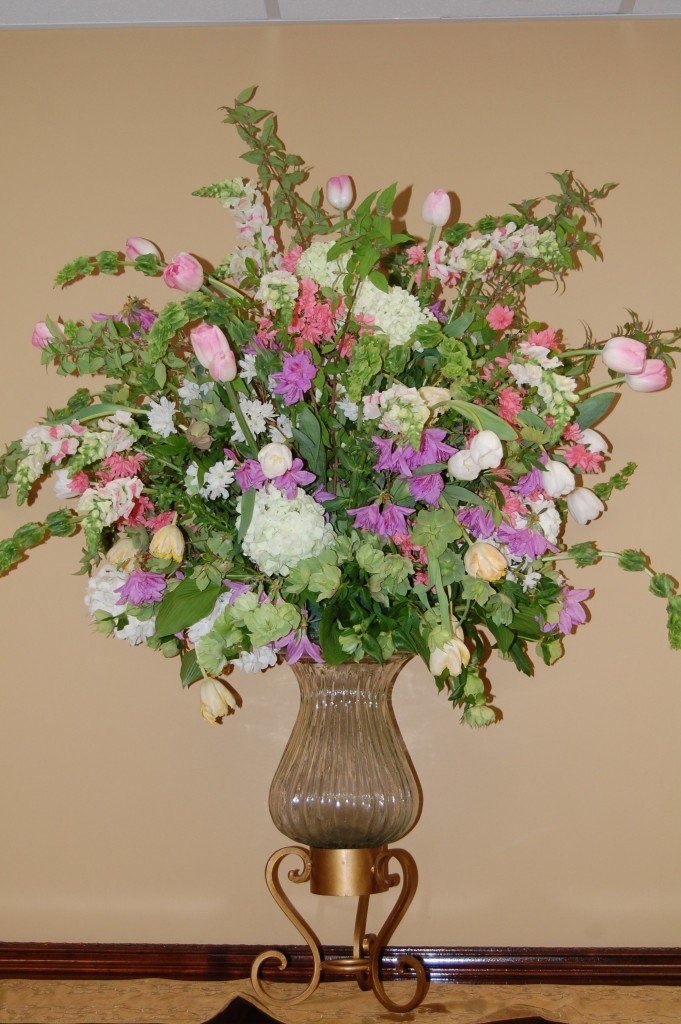 This arrangement welcomes spring in all its glory. Pink and peach Tulips, pink and lavender Azaleas, and pink Snapdragons blend beautifully with Snowball Viburnum (the OTHER Snowball Viburnum, Viburnum macrocephalum), Lenten Rose, Deutzia gracilis and greens.
This arrangement welcomes spring in all its glory. Pink and peach Tulips, pink and lavender Azaleas, and pink Snapdragons blend beautifully with Snowball Viburnum (the OTHER Snowball Viburnum, Viburnum macrocephalum), Lenten Rose, Deutzia gracilis and greens.
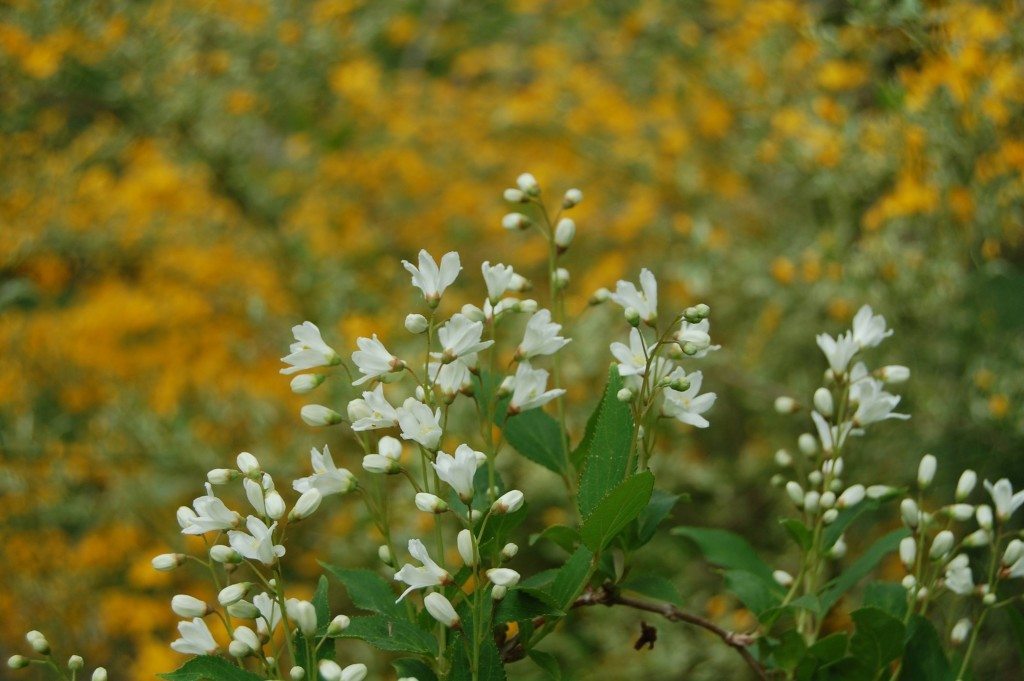
Slender Deutzia (Deutzia gracilis) in the foreground, Kerria japonica in the background.
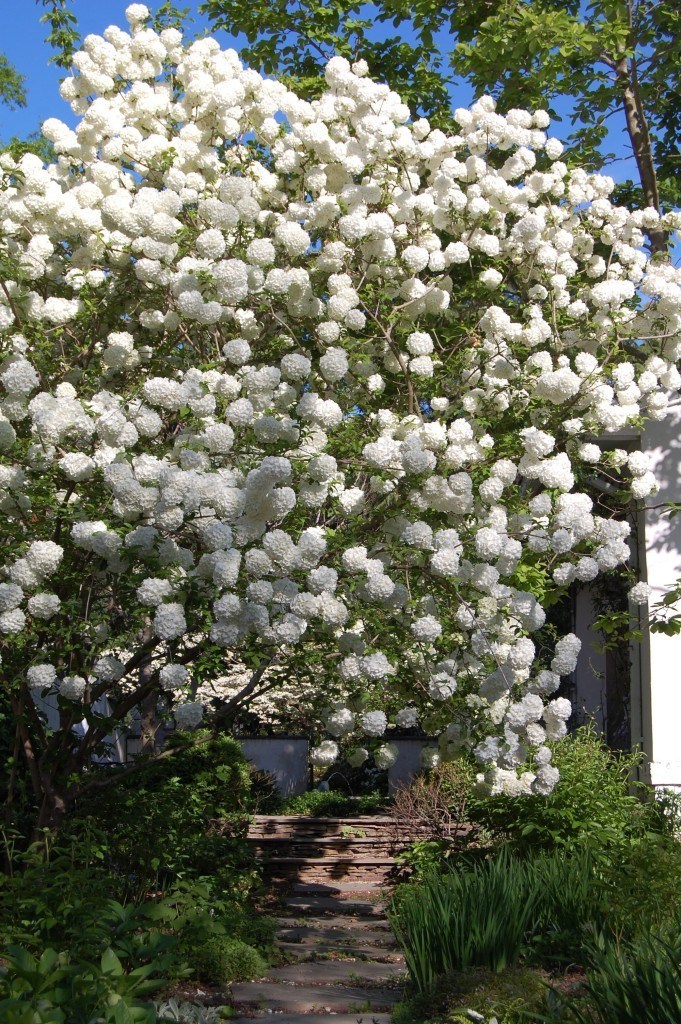
Snowball Viburnum (Viburnum macrocephalum) can be trained into a multi-trunk tree.
[custom-related-posts title=”Related Posts” none_text=”None found” order_by=”title” order=”ASC”]
HISTORIC GARDEN WEEK 2015: LOTS TO DO
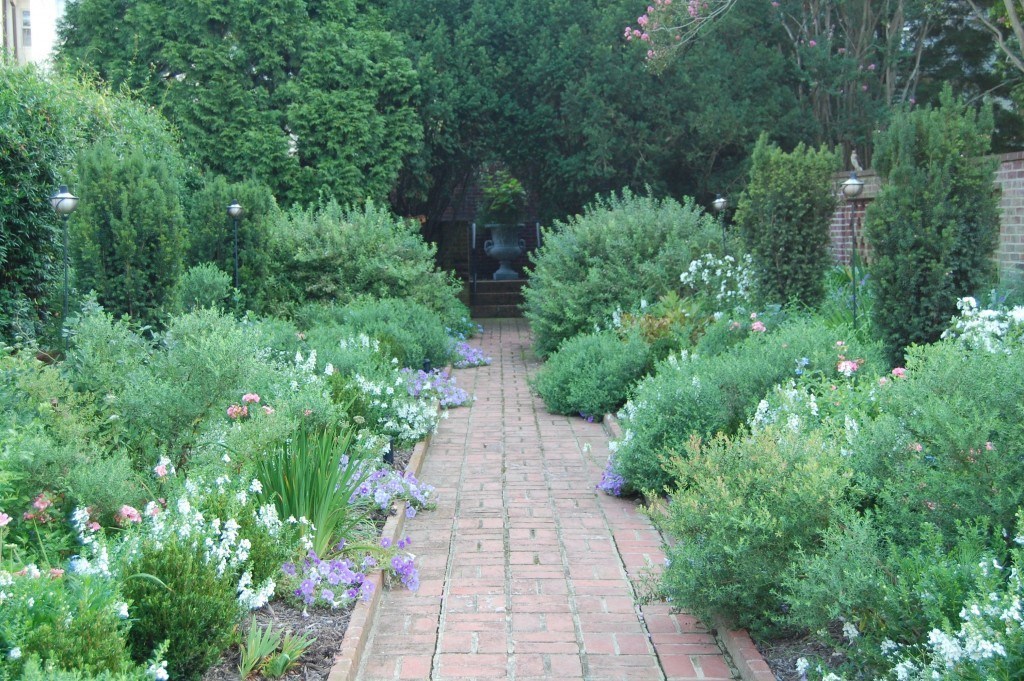
Historic Garden Week, presented by the Garden Club of Virginia since 1927, is underway in Richmond. We’ve ordered up some gorgeous weather, so call in sick, grab a buddy, tie up your mucky shoes and see some fabulous gardens.
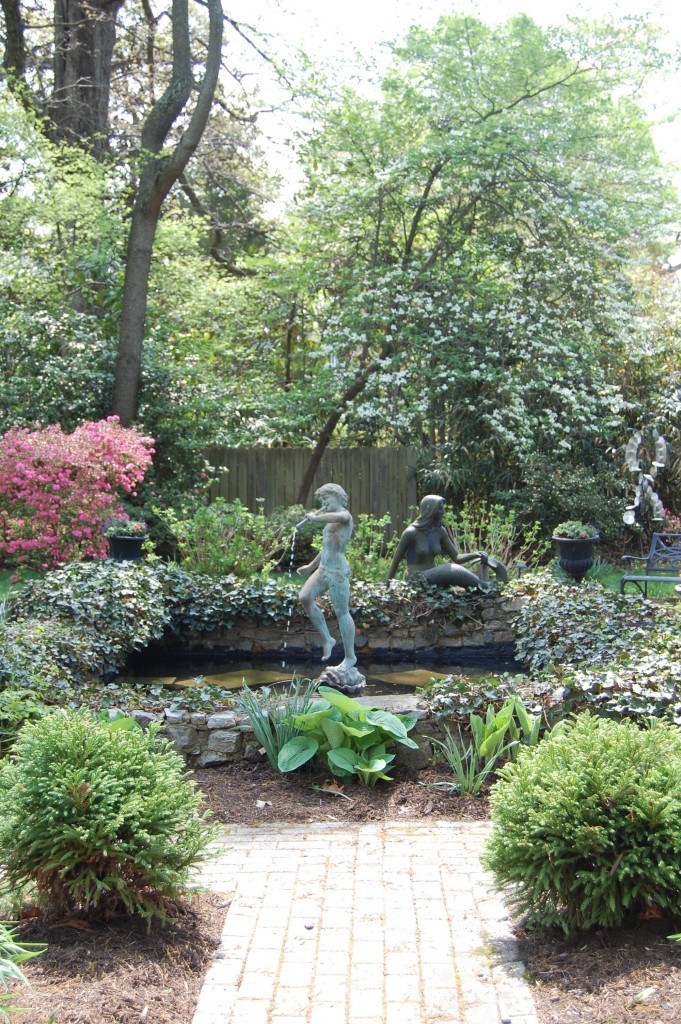
Wednesday’s tour is the Hermitage Road area. Most of the homes in this Ginter Park neighborhood were built in the late 1800s and early 1900s. Wrenford, above, was built in 1896.
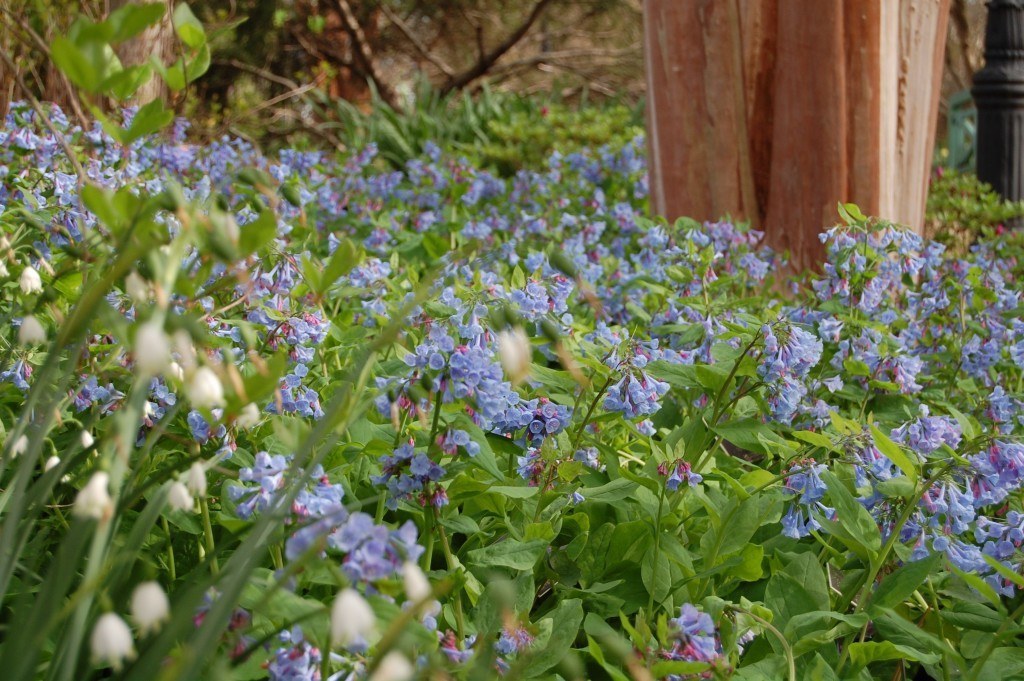
While you’re out that way, grab a burger at Roy’s Big Burger (make it part of a picnic at nearby Bryan Park), then head down the street to Lewis Ginter Botanical Garden to see the Virginia Bluebells (Mertensia virginica), above, and thousands of blooming bulbs, trees, shrubs and perennials.
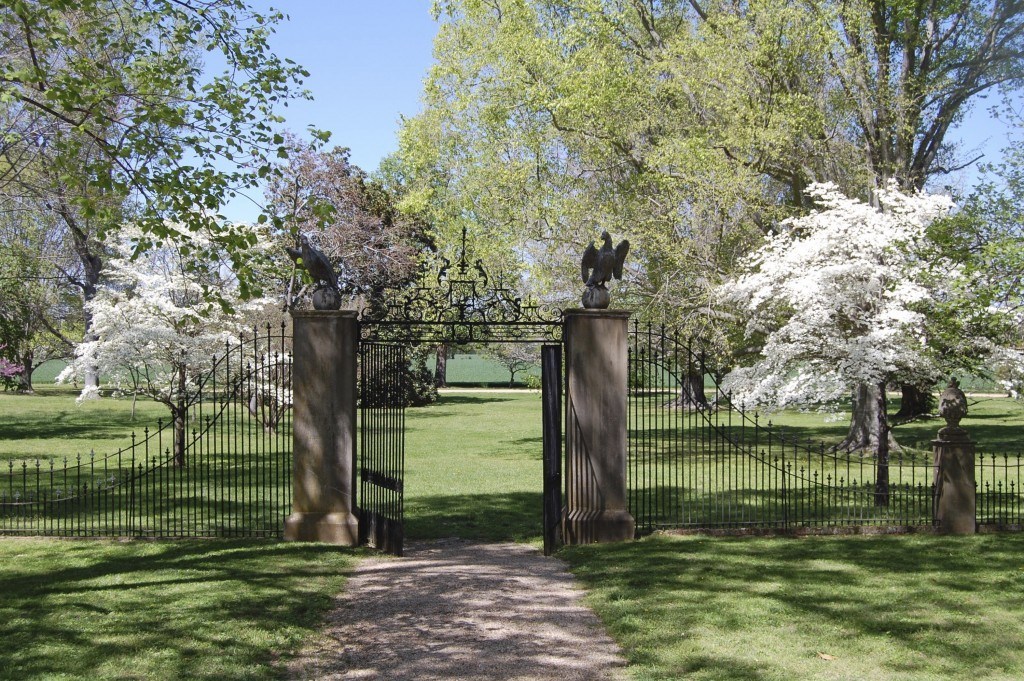
Also open Wednesday is Westover Plantation, built by the Byrd family in the eighteenth century. If you’re up for a relaxing drive along a country road, head east on Route 5 to see one of the finest examples of Georgian architecture in the United States.
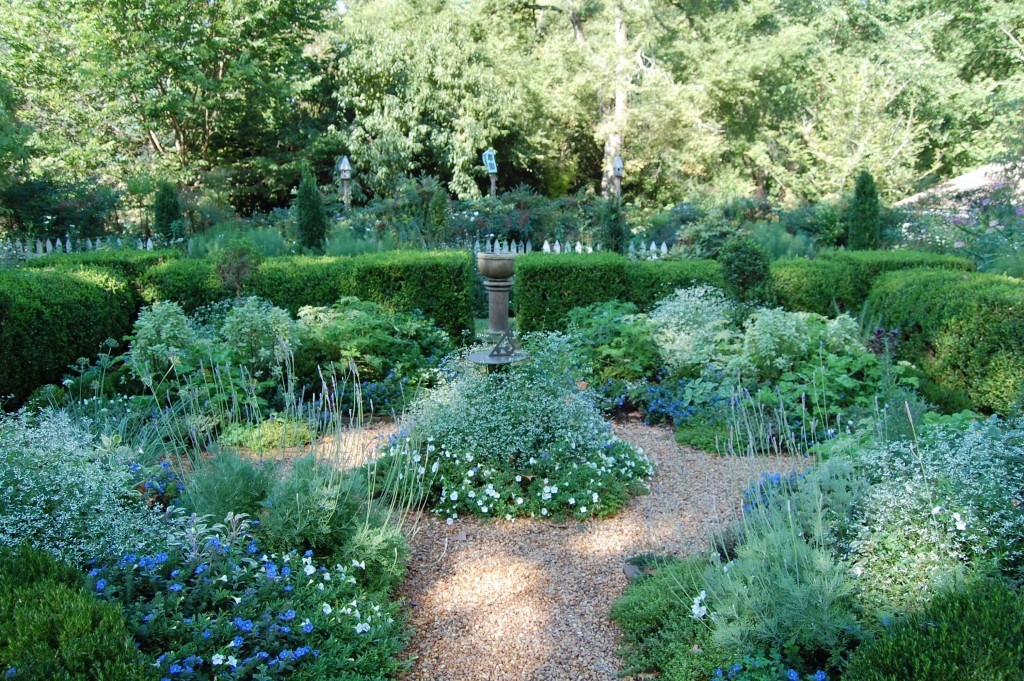 If you loved your drive east to Westover, turn around and head west to Tuckahoe Plantation, the boyhood home of Thomas Jefferson. Tuckahoe is open Wednesday through Friday as part of the Richmond tour. Mr. Jefferson would be proud that the Thompson family has lovingly restored and cultivated the gardens, providing a feast for the eyes and many lessons for nature lovers and experts.
If you loved your drive east to Westover, turn around and head west to Tuckahoe Plantation, the boyhood home of Thomas Jefferson. Tuckahoe is open Wednesday through Friday as part of the Richmond tour. Mr. Jefferson would be proud that the Thompson family has lovingly restored and cultivated the gardens, providing a feast for the eyes and many lessons for nature lovers and experts.
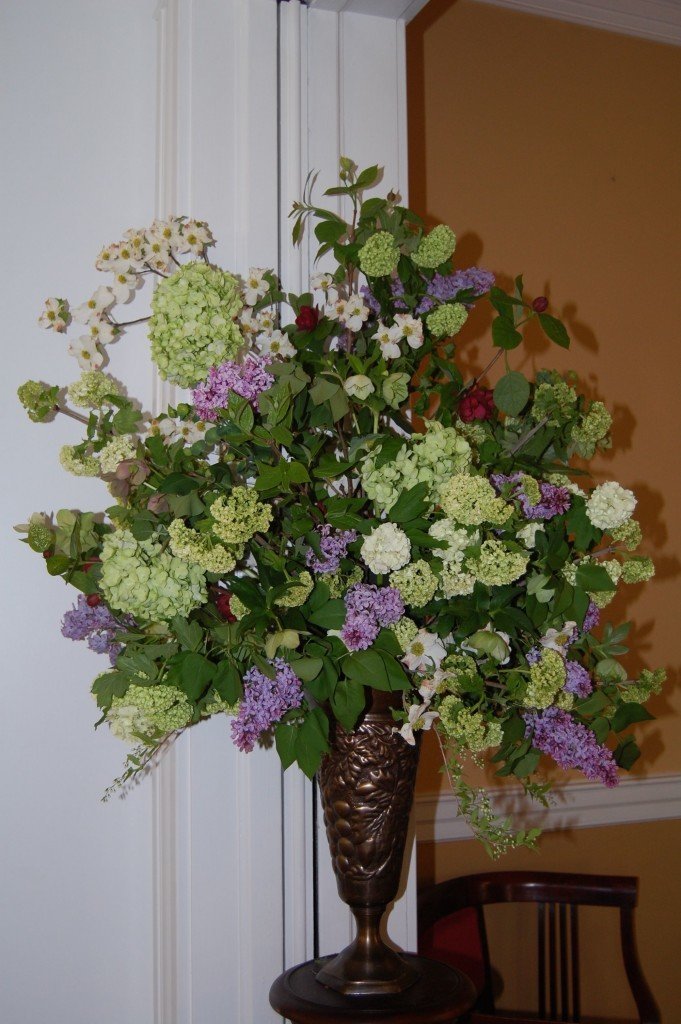
Thursday’s tour is of the homes and gardens on Kingcrest Parkway, just a stone’s throw from the corner of Malvern and Grove. While touring the homes, take note of the spectacular arrangements created by members of the Boxwood, James River, Three Chopt and Tuckahoe garden clubs. I’ll share more of these arrangements in a later blog post. To see some past Garden Week arrangements, visit my prior blogs.
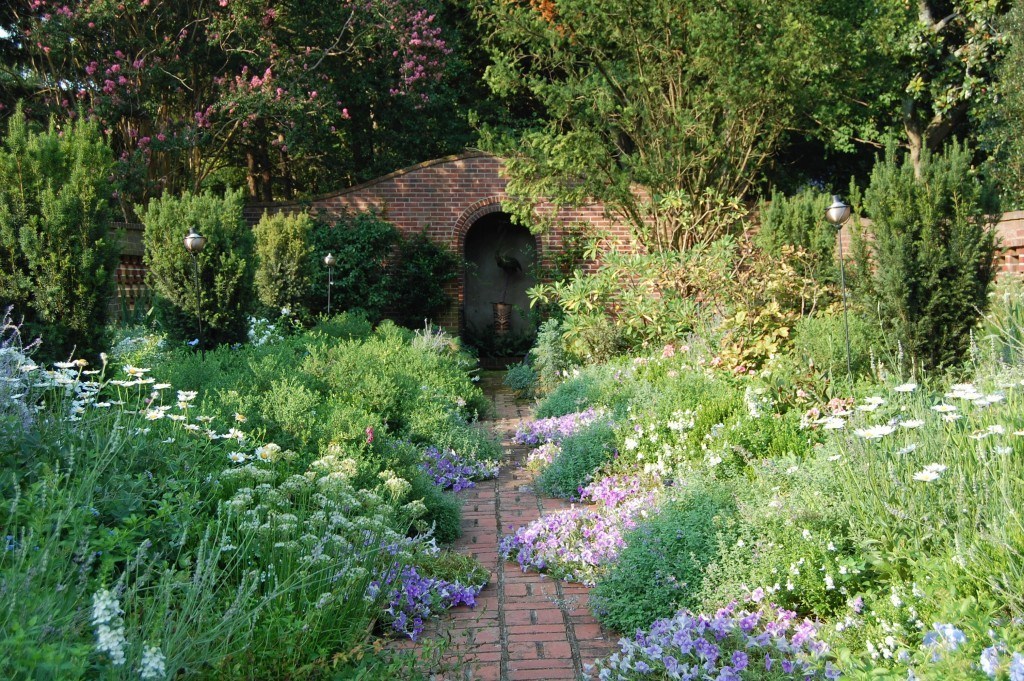
Friday’s tour takes place along the Cary Street corridor. Robin Hill, above, originally was a farm overlooking the James River. Eventually, some of the property was sold off and developed as the Hillcrest neighborhood, but four and a half acres were preserved, and now contain extensive brick and stone pathways, allees, perennial and shrub borders water features and secret gardens.
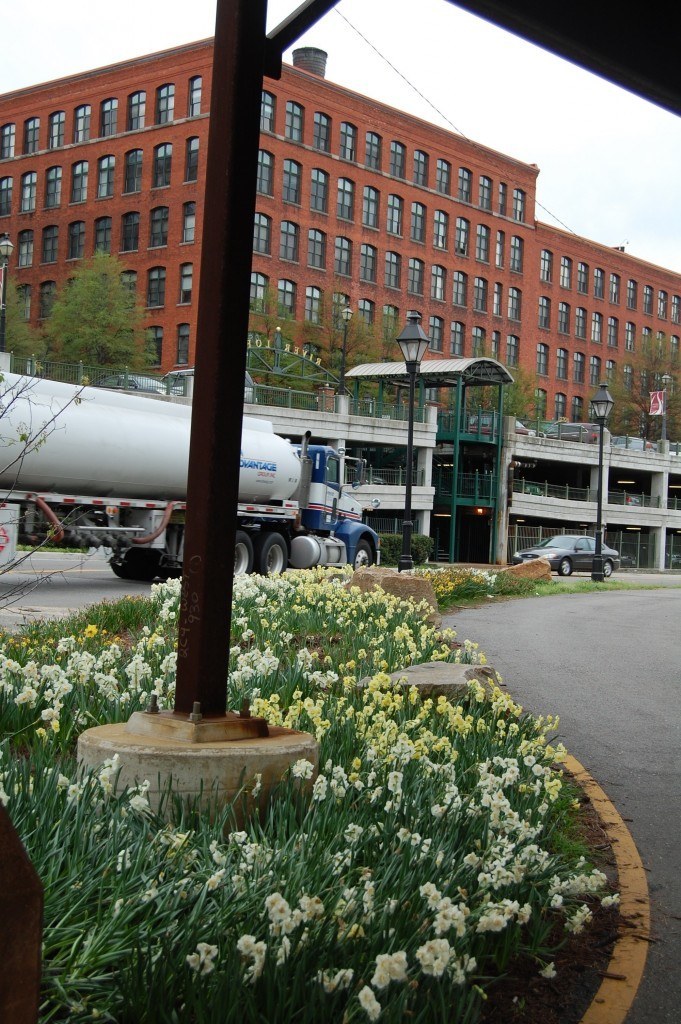
After checking off all those homes and gardens on your Green Ticket, go grab a beer in Shockoe Bottom, then check out the 15,000 Daffodils (with a river of Bluebells running through them) along Dock Street. Capital Trees planted the bulbs along the Virginia Capital Trail, after working with the Virginia Capital Trail Foundation to renovate Great Shiplock Park just to the East. Stay tuned to hear about more exciting plans for this area in the near future.
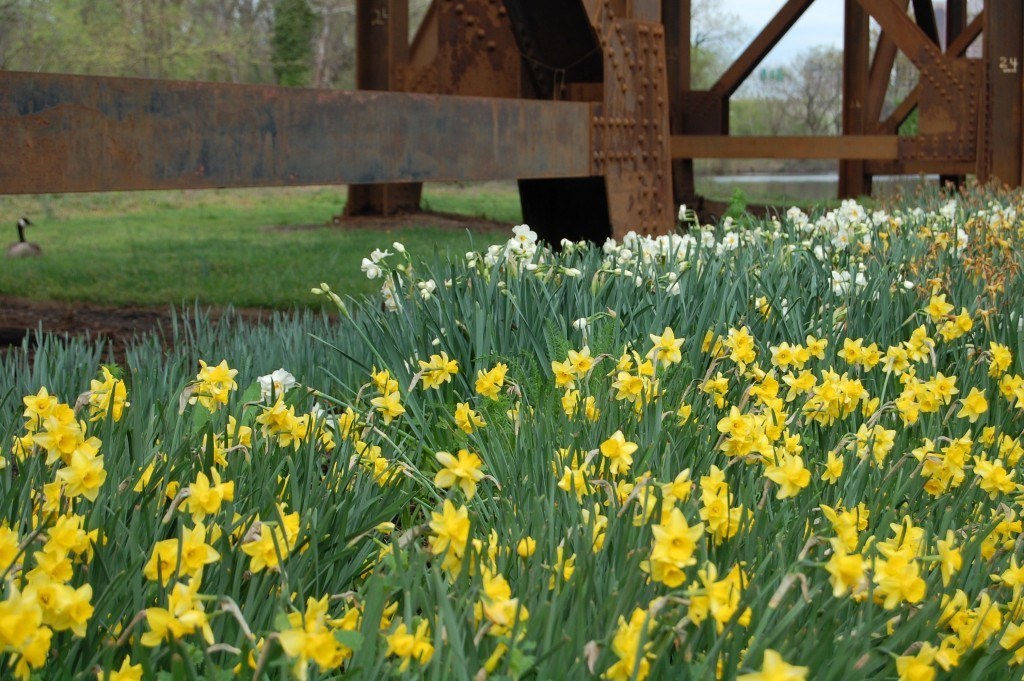
EARLY SPRING GARDEN CHORES
For those restless gardeners who, like me, are checking their gardens daily for signs of life, grab your pruners and head outside, because it’s time to:
Cut back Liriope with the lawn mower or string trimmer.
Cut back to the ground any Lenten Rose (Helleborus orientalist) or Christmas Rose (Helleborus niger) leaves that are browning or leathery. Most old leaves announce themselves by collapsing flat on the ground — just as we do at the end of the day!
New growth and flowers should already be emerging.
Prune to about 2 inches high all perennials not cut back in fall.
Exceptions: cut back Perovskia atriplicifolia (Russian Sage) to about 6 inches, cut back Salvia microphylla/greggii (very similar, often confused) to about 4 inches. These are both woody perennials.
DO NOT cut back Tree Peonies! They bloom on old growth.
Remove dead and discolored Stachys byzantina foliage (Lamb’s Ears).
Prune ornamental grasses all the way back.
Don’t prune before early March, since the winter color and movement are two of their best features.
Exception: Try raking, rather than pruning, Muhly Grass (Muhlenbergia capillaris), for thicker new growth.
Prune dying leaves of evergreen ferns (many of the fronds still look great — I can’t usually bring myself to cut these just yet).
HYDRANGEAS
Prune Annabelle Hydrangeas (Hydrangea arborescens), if you did not do so in the fall. by cutting back all branches to 6-12 inches high.
Unlike the Mophead Hydrangeas, Annabelles bloom on new wood.
You can still prune the everblooming Hydrangeas, as they bloom on new and old wood (you will be cutting out some of the flowering buds that have set on the old wood).
You can also prune Hydrangea paniculata now (includes Pee Gee, Limelight, Tardiva cultivars).
LIMELIGHT: If you want a full, bushy plant, cut back Limelights to about 2 or 3 feet every spring. Also prune all the little spindly branchlets. If you are training your Limelight into a tree, then merely thin the weaker branches.
TARDIVA: Tardiva has a much nicer growth habit than Limelight and Pee Gee. It naturally grows into a tapering multi-branched small tree. To maintain the multi-branch form, just deadhead last year’s flower heads and any small spindly branches that detract from the form you are trying to attain.
You may snap off last year’s flower heads of old-fashioned Mopheads, Lacecaps and Oak Leaf Hydrangeas, and you may cut out the oldest unproductive branches, but do not give these Hydrangeas an overall haircut right now. They bloom on old wood.
Work aluminum sulphate into the soil in which blue Hydrangea are growing, to make the blooms bluer. Add lime to make the blooms pinker.
OTHER SHRUBS AND TREES
Prune Buddleia davidii (Butterfly Bush) to about 2 feet and remove spindly and dead branches, if you want a full bushy plant. If you want a Butterfly Bush that resembles a small multi-trunk tree, only cut out straggly branches. Prune the dwarf Buddleias to about 2 feet wide and one foot tall.
Cut back Caryopteris x clandonensis (Bluebeard) to about 18 inches.
Prune Callicarpa (Beautyberry) to about 6 inches.
Prune Sasanqua Camellias (fall and early winter blooming Camellias) now, only if needed to shape or reduce size.
“Pinch” or hand prune Boxwood to thin and open up the plant. This allows light and air inside so that the plant can produce leaves along the interior surfaces. This is especially important to protect the Boxwood from Boxwood Blight. The Virginia Coopertative Extension Service, North Carolina State University and Saunders Brothers Nursery are good resources for keeping up with the latest on the blight. If planting Boxwood, be sure to ask your landscaper or the nursery whether the Boxwood come from a nursery that adheres to the Boxwood Blight Cleanliness Program.
If your Poet’s Laurel (Danae racemosa) has not been pruned in a few years, cut it back to the ground. Poet’s Laurel produces new growth from the earth, not from other branches. You can continue to do the full cut back (the Frank Cut) every spring; you can do the Frank cut every 2 or 3 springs; or you can just cut out the oldest third of growth every spring.
DO NOT prune any spring-flowering shrubs or trees until after they bloom! Exception: Dead or diseased branches can always be removed.

Camellia Japonica blooms in late winter or spring, depending on the cultivar. It should not be pruned until after it finishes blooming.
Prune Vitex agnus-castus (Chastetree) by cutting suckers back to the ground or back to the intersection with a larger branch. Remove some large branches to provide a nice, open shape to the small tree/shrub. You can also cut Vitex way back, if it has gotten out of control.
DO NOT COMMIT CRAPE MAIMING!!!!!!!!!!!!!!!!!!!!!!! Topping Crape Myrtles does nothing except disfigure the tree. Feel free to thin Crapes now, by cutting out weaker branches and sprouts. See my earlier post for more information on proper Crapemyrtle pruning.
ROSES
Prune Shrub Roses to about 12 to 18 inches. Make cuts about a quarter of an inch above an outward facing bud. Also remove any branches with diameter less than a pencil, and any diseased or dead branches.
Prune Climbing Roses. Cut out all dead and diseased canes, any crossing or spindly canes and some of the oldest (increasingly less productive) canes. Tie the branches to your support.
Begin feeding roses every six weeks throughout the growing season. While I generally avoid fertilizing plants unless they are showing signs of deficiency, roses are an exception because they are gluttonous feeders.
OTHER CHORES
Work compost into the soil to keep it healthy and provide a source of nutrition for the plants.
Apply mulch ONLY if needed. When you do mulch, consider mulching with half or all compost or a layer of shredded leaves and another inch of finely ground mulch. If the mulch applied earlier has not broken down, do not apply more. Sometimes, overzealous mulching leads to an impenetrable mat that traps moisture, thus inviting disease. Rake loose the existing mulch to allow air and rain through to the soil. Also, be sure not to lay the new mulch too thick — especially in perennial beds.
PLEASE DO NOT volcano mulch around trees! Volcano mulch is the term used to describe mulch piled up in a big mound around a tree. When mulch rests against a tree trunk, it traps moisture, softening the trunk and inviting pests and disease. Over time, the tree will decline and die. Richmond Tree Stewards recommend the 3x3x3 rule: no more than 3 inches of mulch, in a 3 foot wide circle, stopping 3 inches from the trunk.
“The opening of the first buds, and the resurrection of plants that looked to be dead, fill the gardener with an enthusiasm that is as perennial as the season.” Elizabeth Lawrence, A Southern Garden
GO VERTICAL! (IN THE GARDEN)
It’s often said that winter is the perfect time to study your garden’s bones. As you do so, look up! Pay special attention to your garden’s vertical elements. Incorporating walls, fences, arbors, trellises, trees and shrubs can solve many problems and will add interest and beauty to your landscape.
SEPARATION
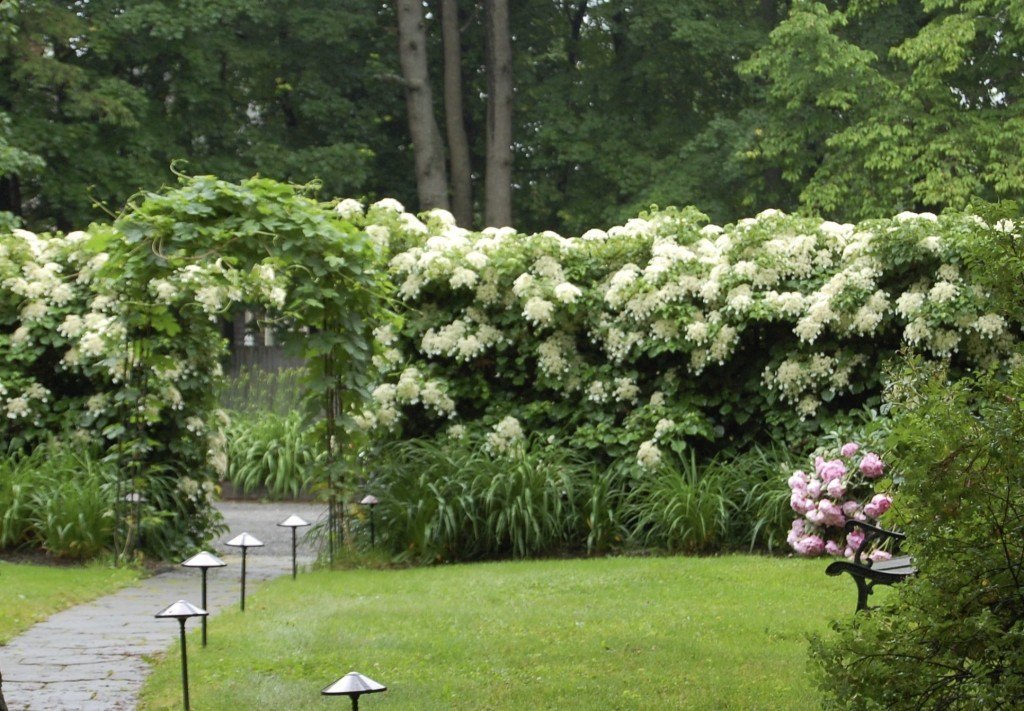
Whether you want to screen a driveway, gain a bit of privacy, or just provide transition from one garden space to another, vertical elements will do the job. A trellised fence takes up little space (depth) and provides a support for plants. In the picture above, Climbing Hydrangea (Hydrangea anomala subsp. petiolaris) covers a fence.
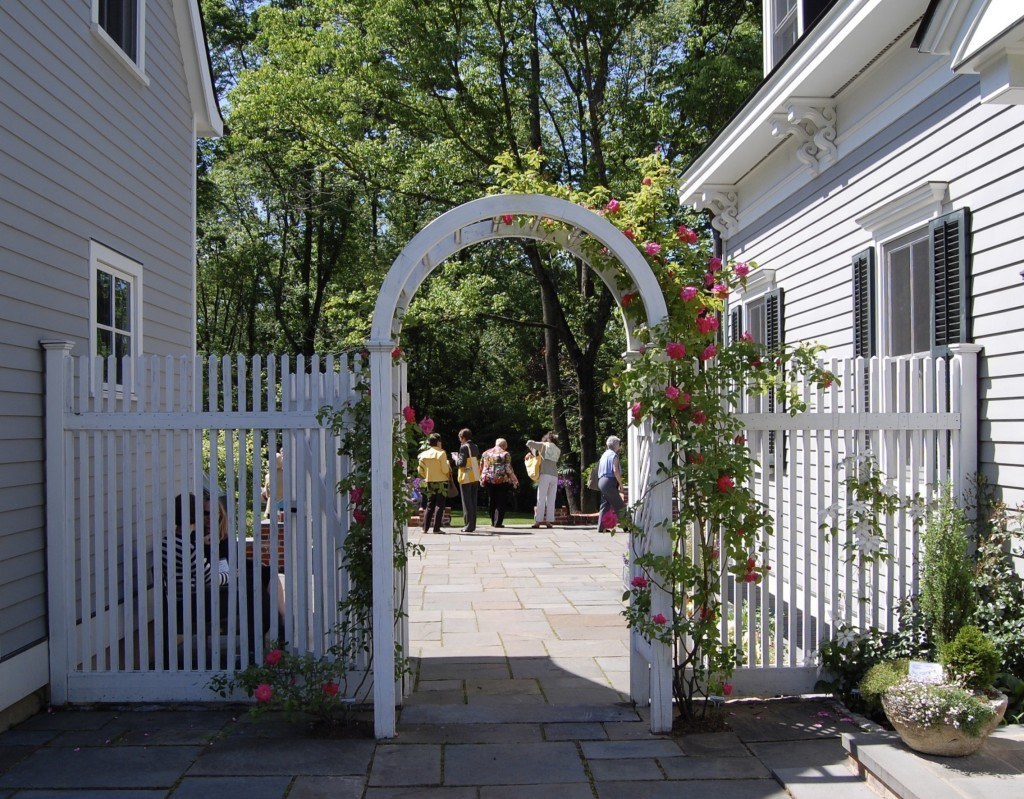
The tall picket fence and arched gate above tackle three issues: they create separation between front and back yards with a light touch, connect the buildings and provide support for roses.
At Dumbarton Oaks, below, a chain connected to stone pillars supports a Wisteria vine and creates a sense of enclosure.
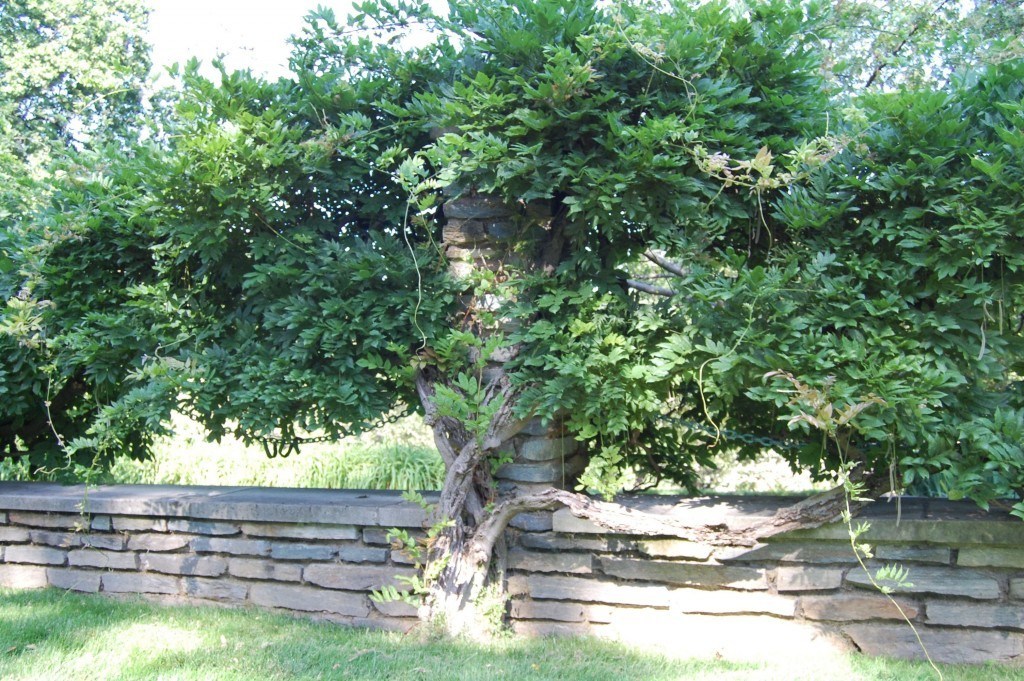
In another area of the gardens at Dumbarton Oaks in Georgetown, Wisteria is pruned to frame the beautiful latticework that physically separates the amphitheatre, without visually screening it. Beatrix Farrand, who designed the gardens, was masterful in using vertical elements to shape the sloping land into separate terraced gardens with brilliant circulation from one garden to the next.
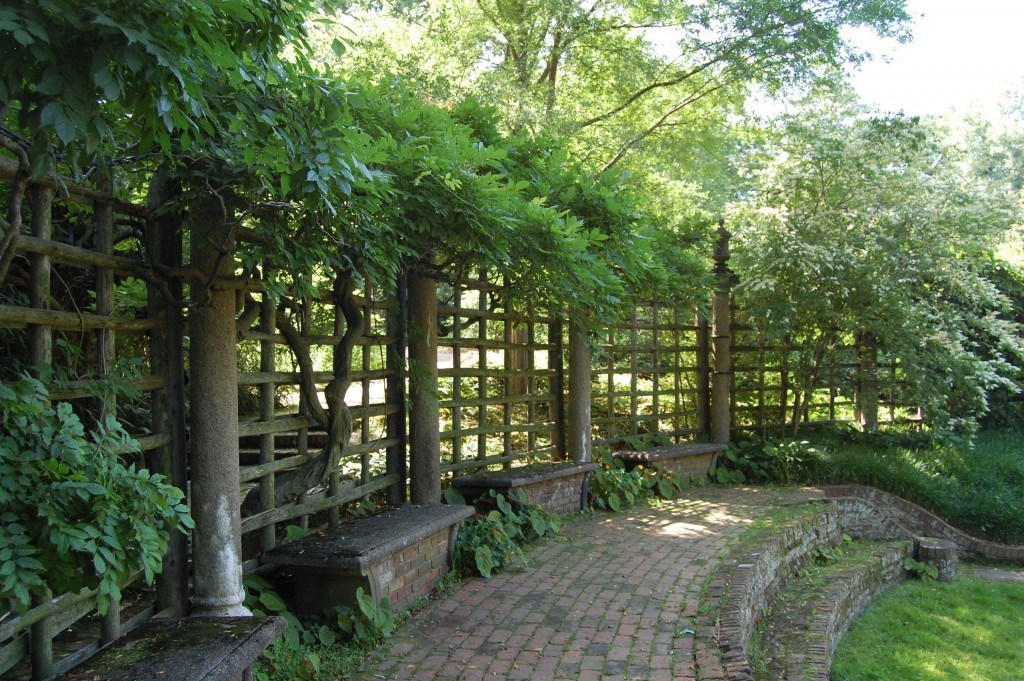
The latticed fence below, anchored by variegated Hosta, defines property lines and provides a connection between the neighbors’ gardens.
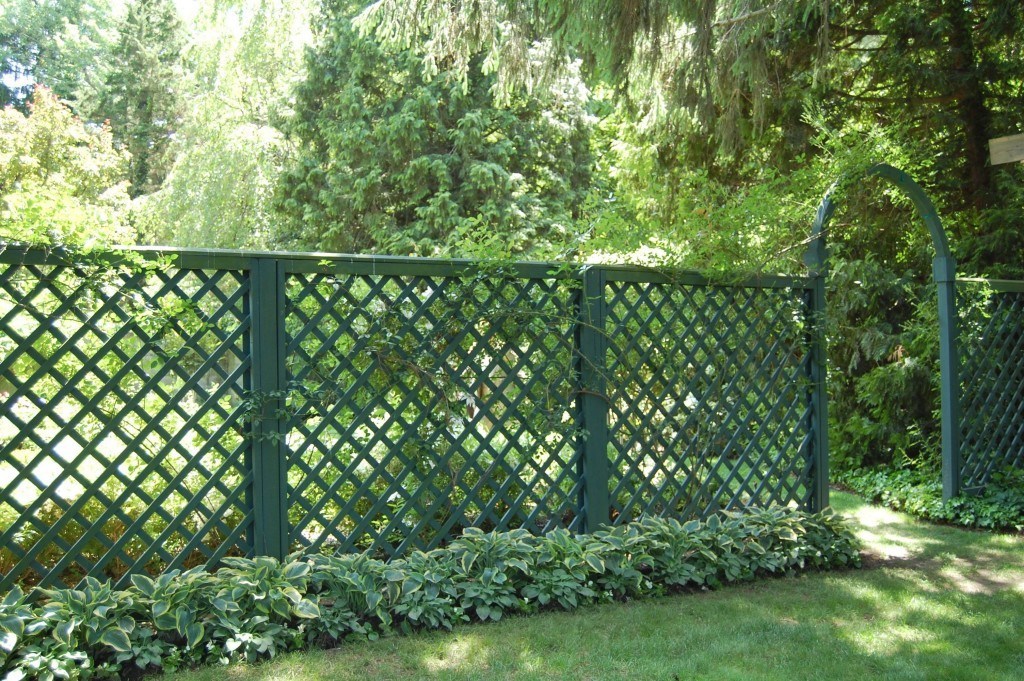
The front entrance, below, in this Kansas City neighborhood is beautifully defined by the stone and wrought iron fence and gate.
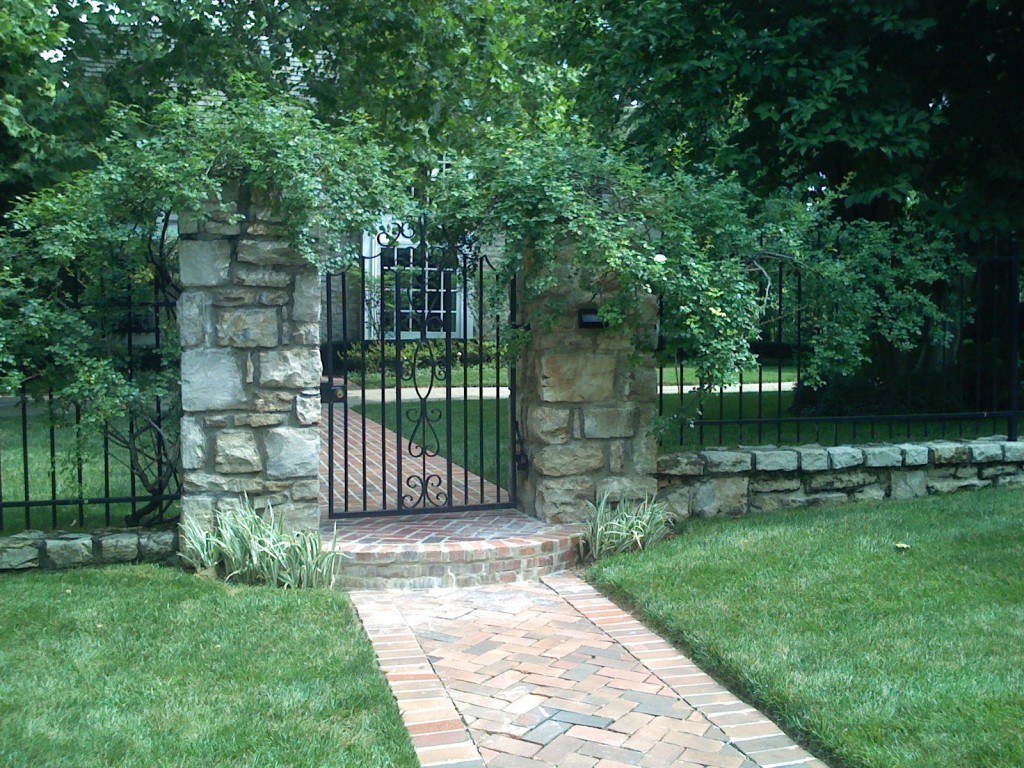
SEPARATION WITH PLANTS: This fruit tree in Lasham, England (I think it was a Pear), one of several along an axis, has been trained to bear fruit and separates the garden into two distinct spaces.
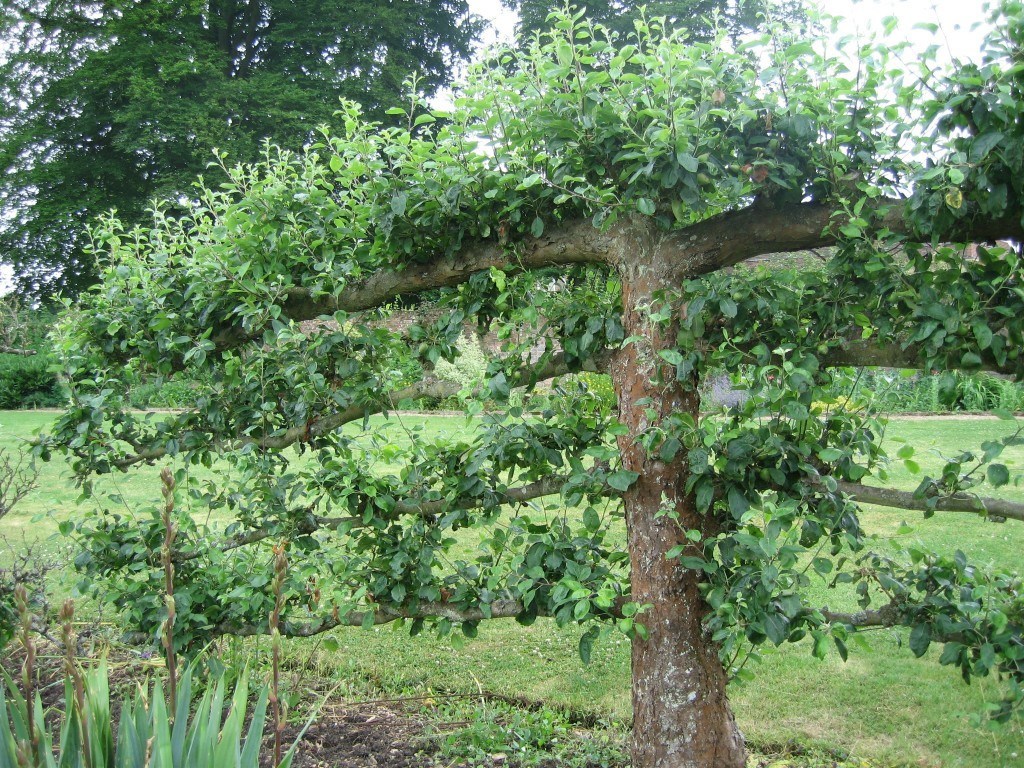
Charleston gardeners are some of the most talented vertical gardeners. In the picture below, the hedge, punctuated by a line of Palmettos, is an effective screen of the parking area. While the English gardener uses the fruit trees, above, only for definition, the Charleston hedge below is tasked with being a visually impenetrable screen.
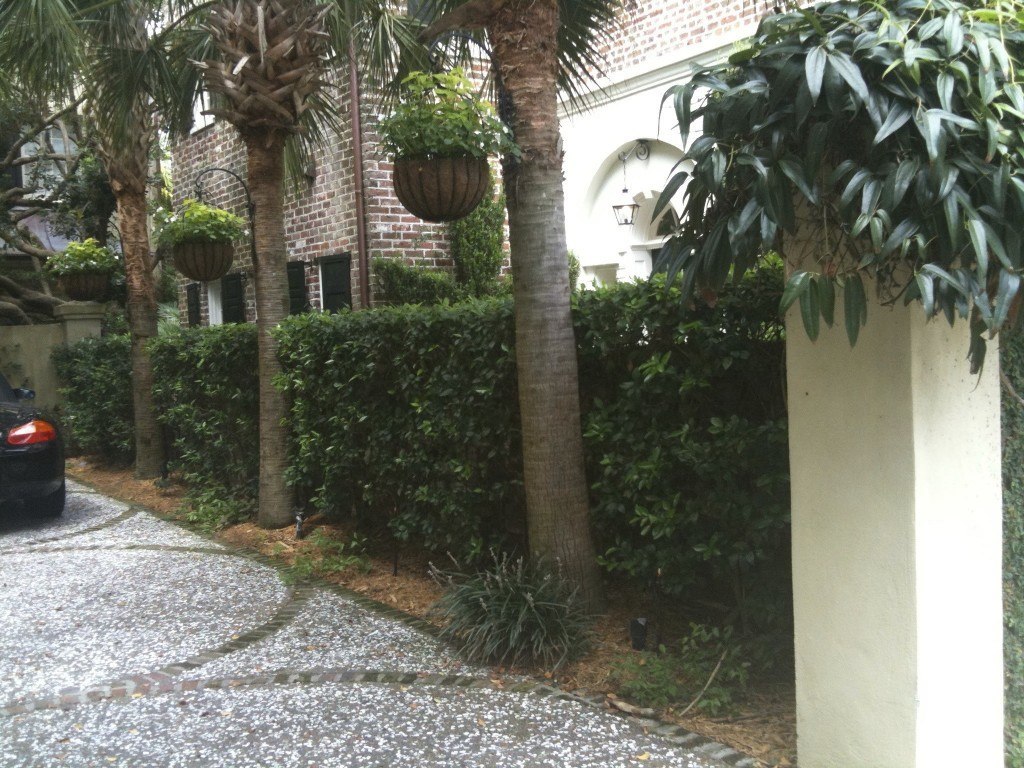
I love the contrast in the English hedge below — tightly clipped (with flanking clipped sentries), yet with a fuzzy unkempt crown and surrounded by unmowed fields.
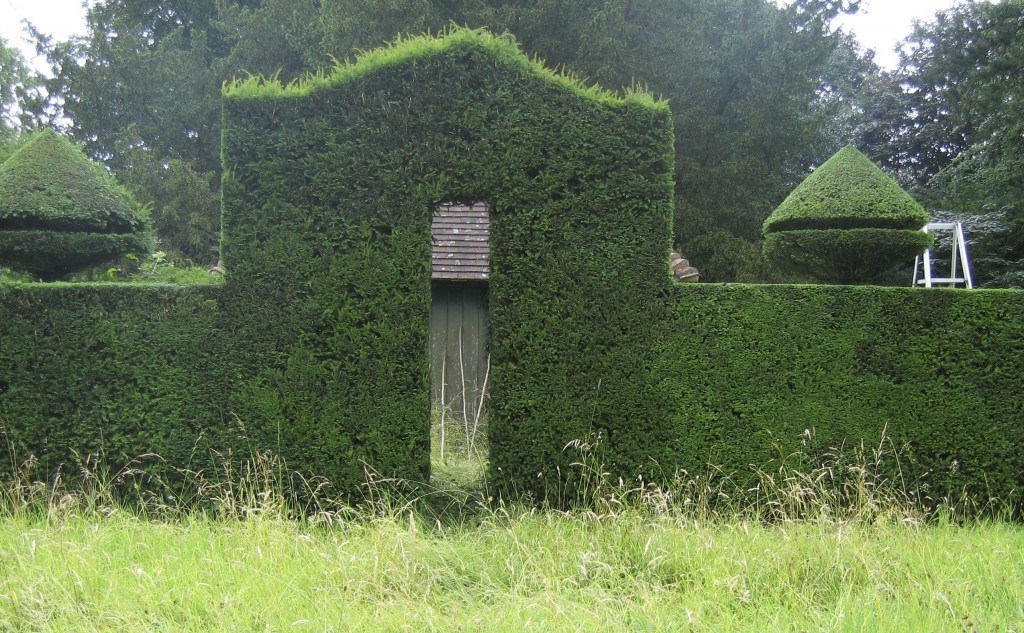
AN EXCUSE TO GROW PLANTS
Give a gardener a structure, and he or she will find a creative way to adorn it with plants. In the pictures below, a talented Princeton gardener espaliers Japanese Maples (Acer palmatum) and Japanese Hollies (Ilex crenata) on a humble cinderblock wall.
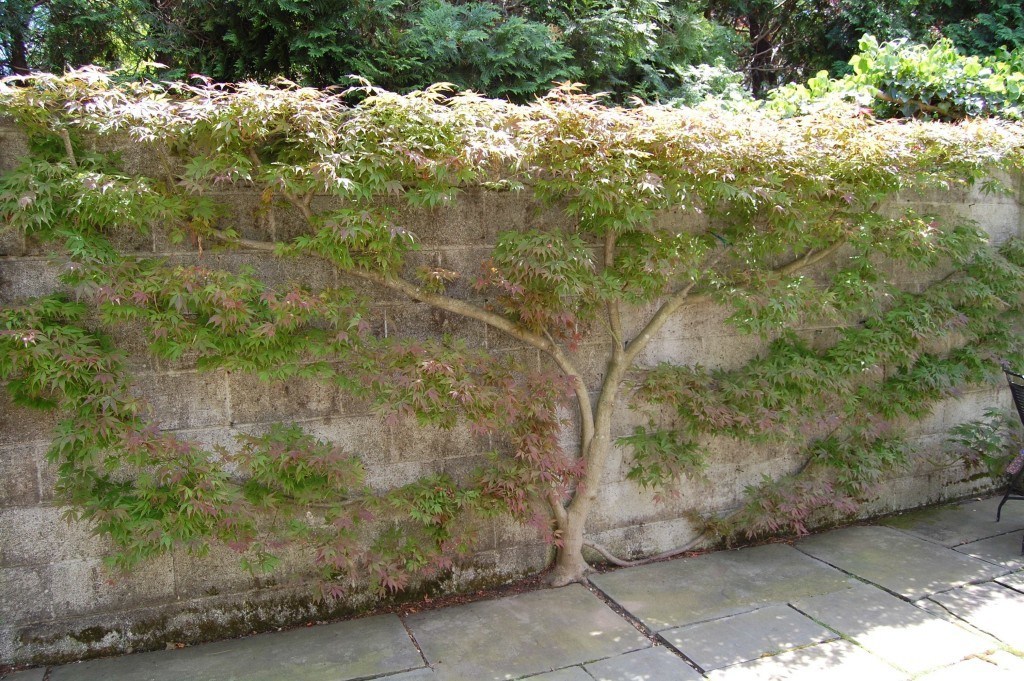
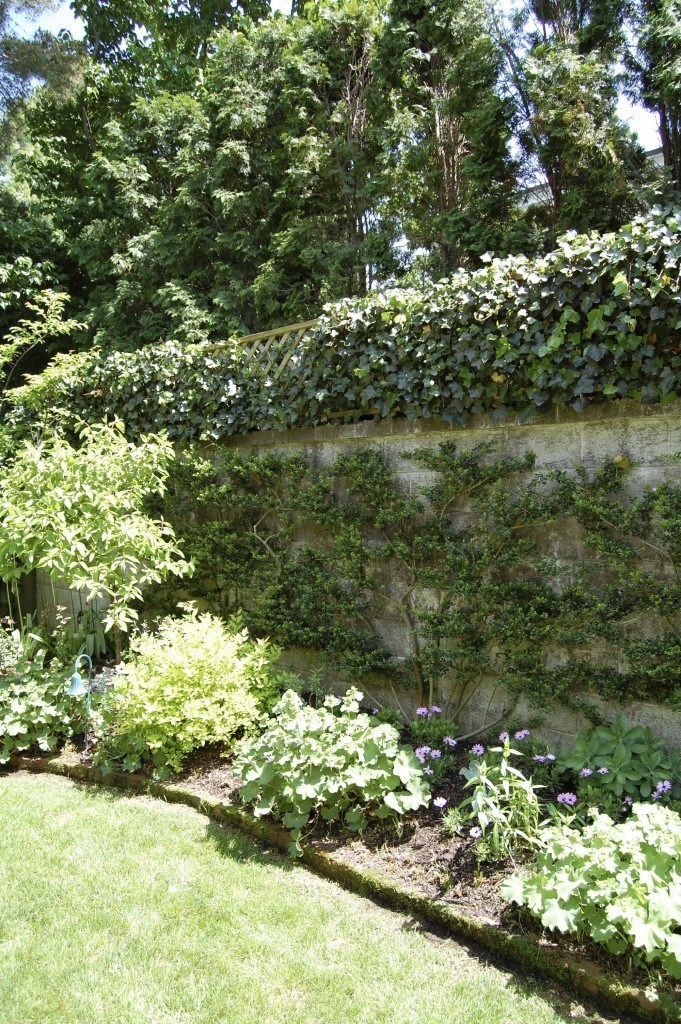
In the same Princeton garden, Climbing Hydrangea frames a window.
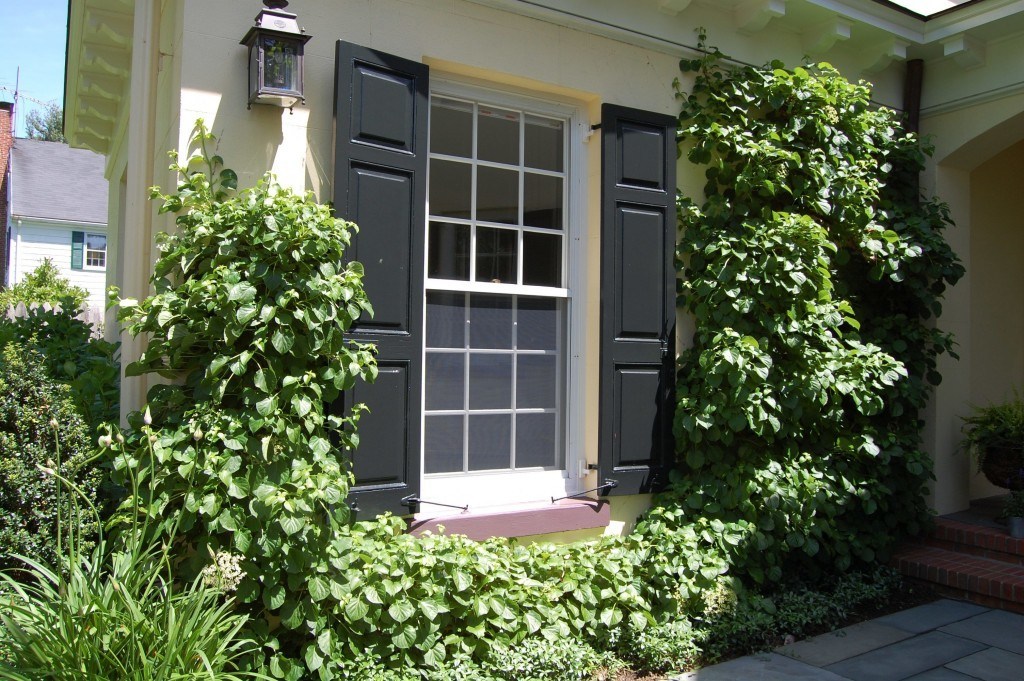
Below, trellises supporting roses complement the architecture and strengthen the symmetry of a formal garden.
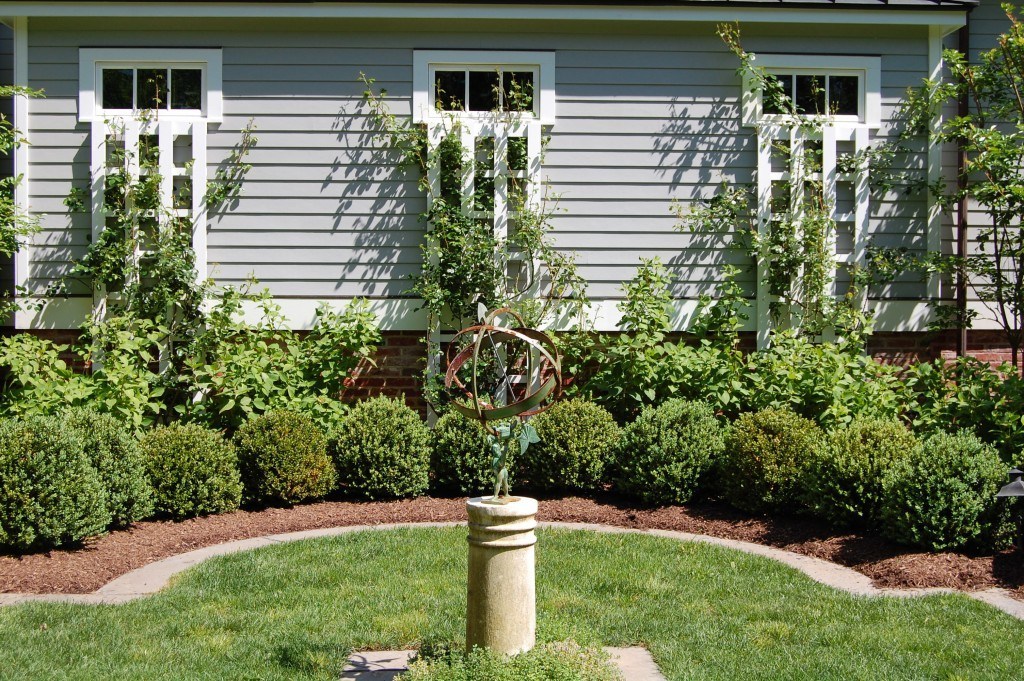
No room to grow Figs or other fruit trees? Espalier them along a wall or strong fence, as is done below.
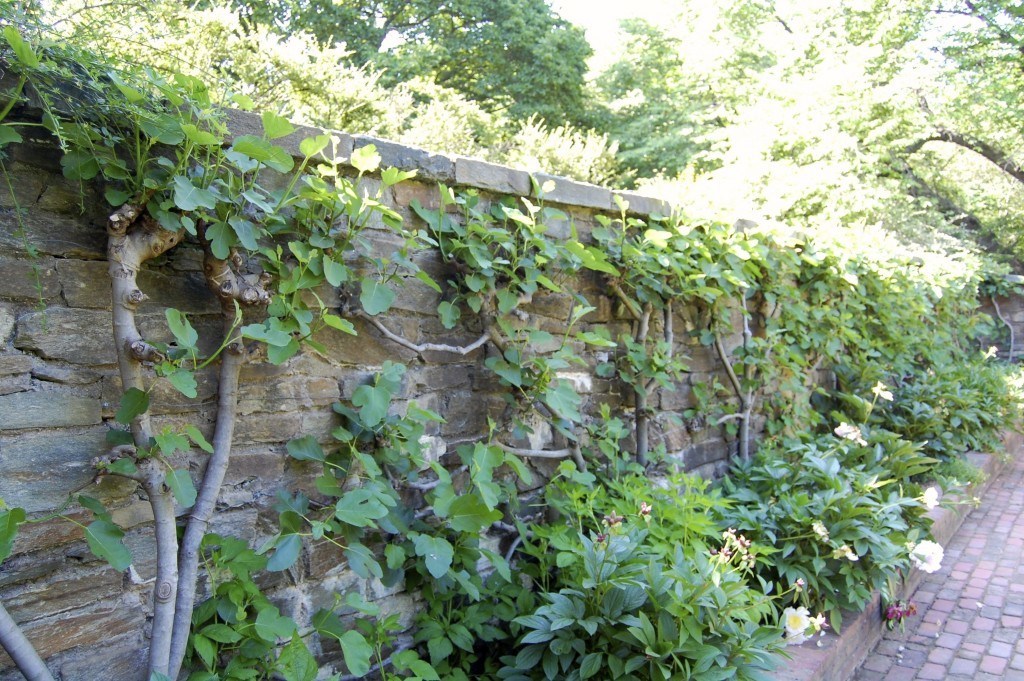
Below: Wall? What wall?
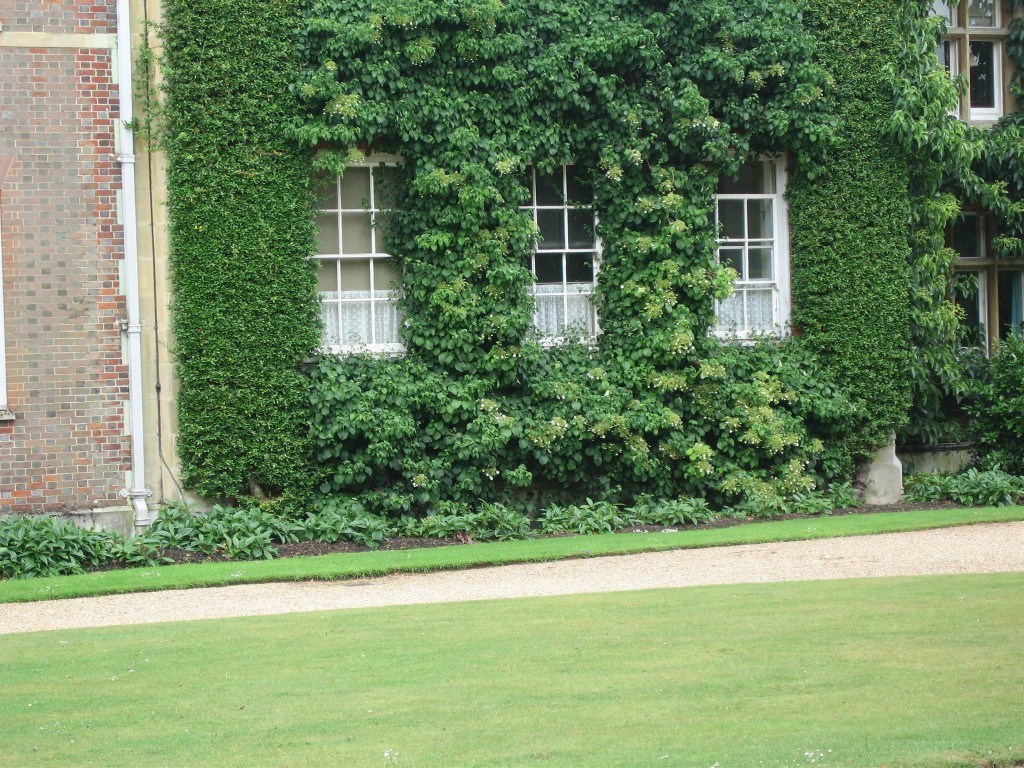
The pale pink and white Camellias (Camellia japonica) growing on the simple gothic trellises transform an otherwise empty weathered concrete wall along a Charleston driveway.
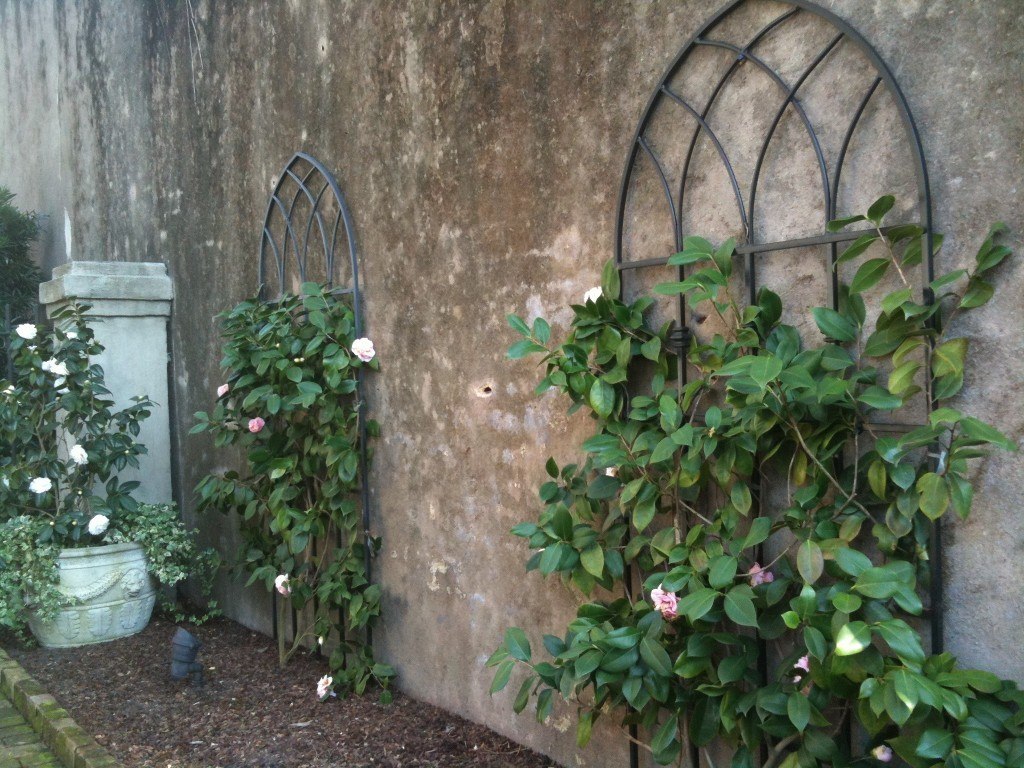
Below, roses smother a thatch-roofed cottage in Lasham, England.
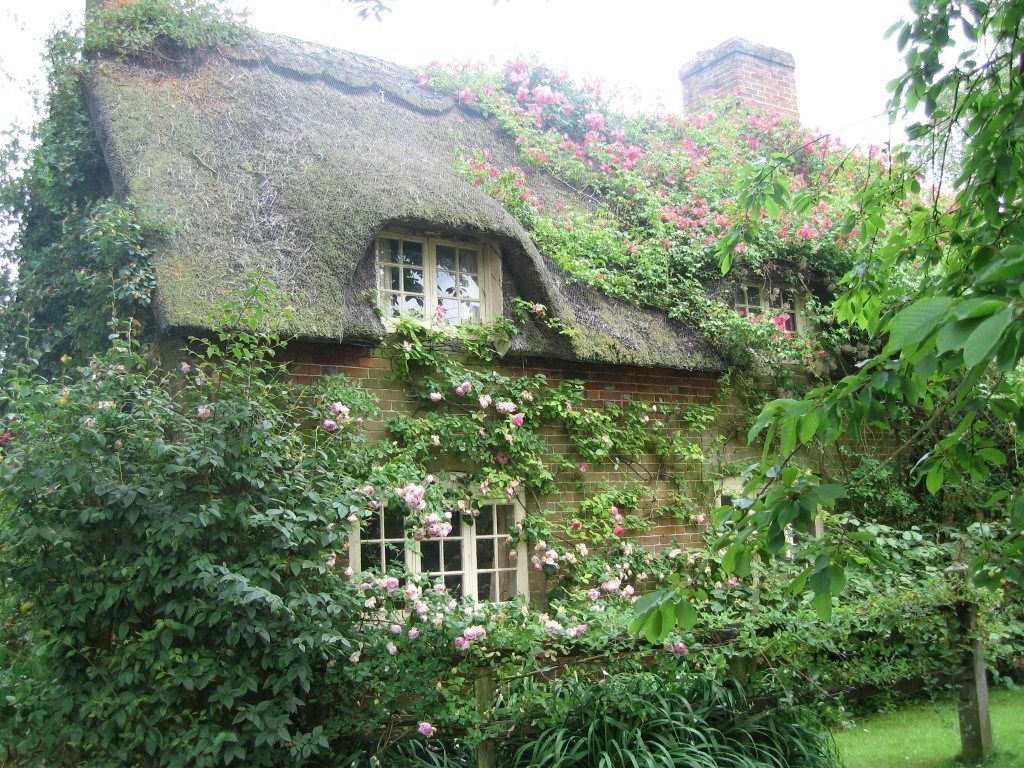
Vertical features don’t just create enclosure and define boundaries. A tuteur or other plant support, like the one below sporting the native Passionflower Vine (Passiflora incarnata), acts as a focal point at Whilton, an exquisite garden near Charlottesville.
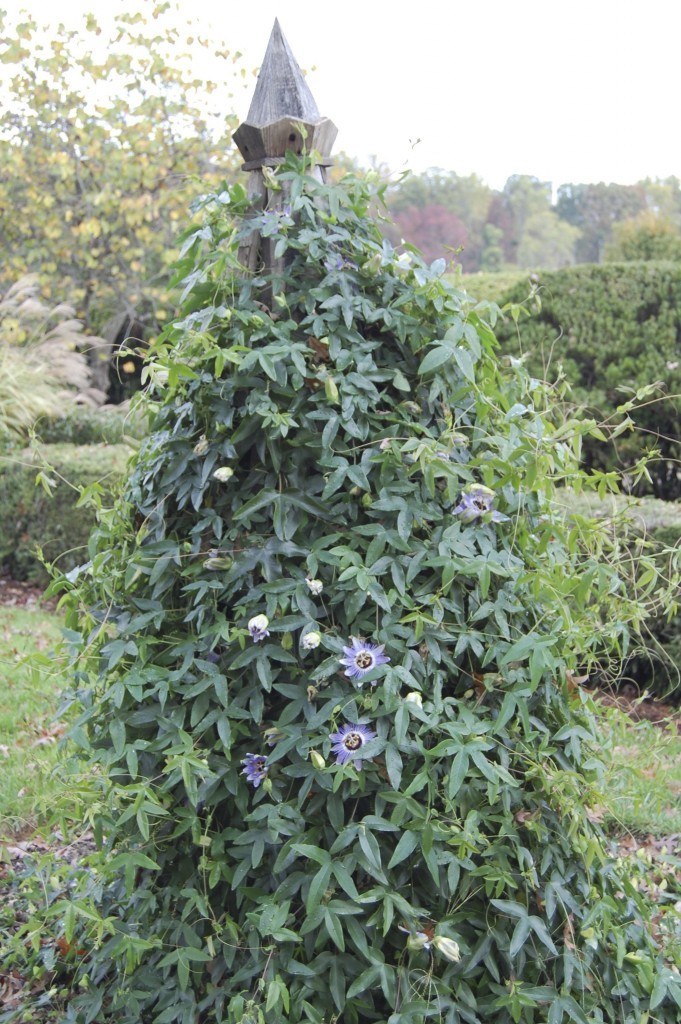
CANOPY
A mature tree canopy is an almost indispensable vertical element in the garden. Not only does it provide vertical interest, it offers shade and dappled light in the garden. In the pictures below, allees are used to define space, act as a guide to a destination and reinforce a strong axial line.
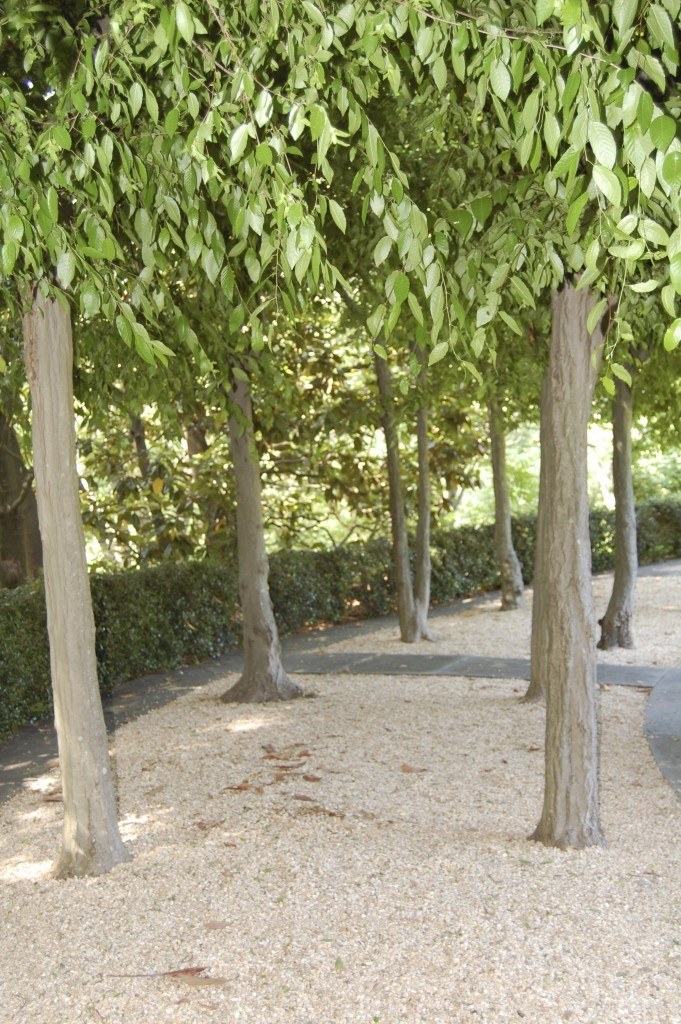
Dumbarton Oaks, above. Whilton, below.
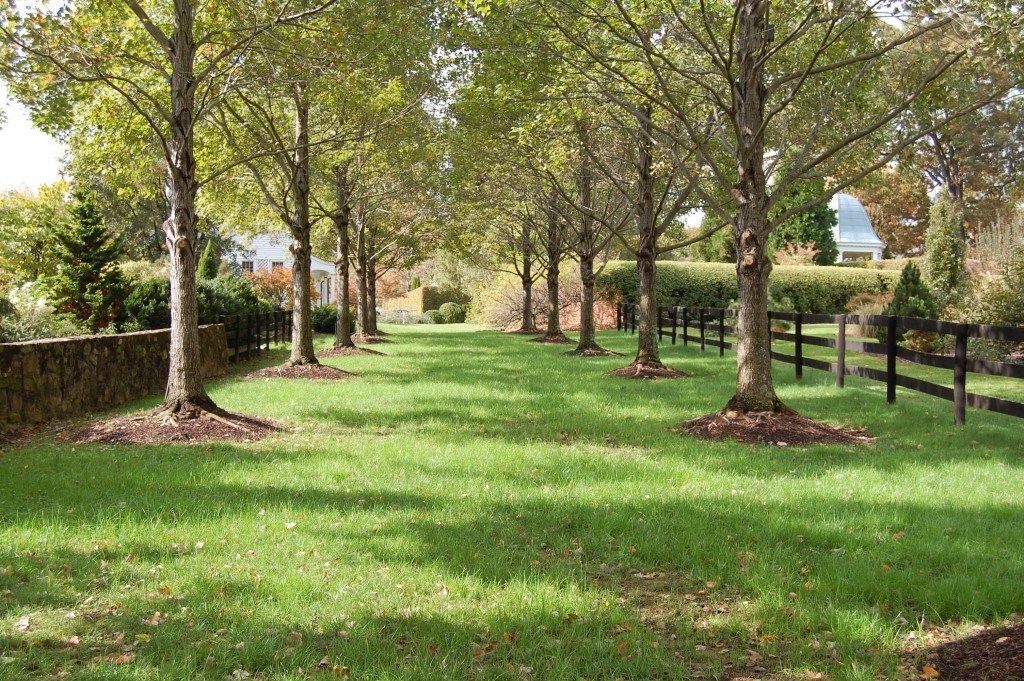
Below, Plane Trees (Platanus x acerifolia) somewhere in Europe (9 years ago — can’t remember!). The width of the path is inexplicably out of scale with the allee.
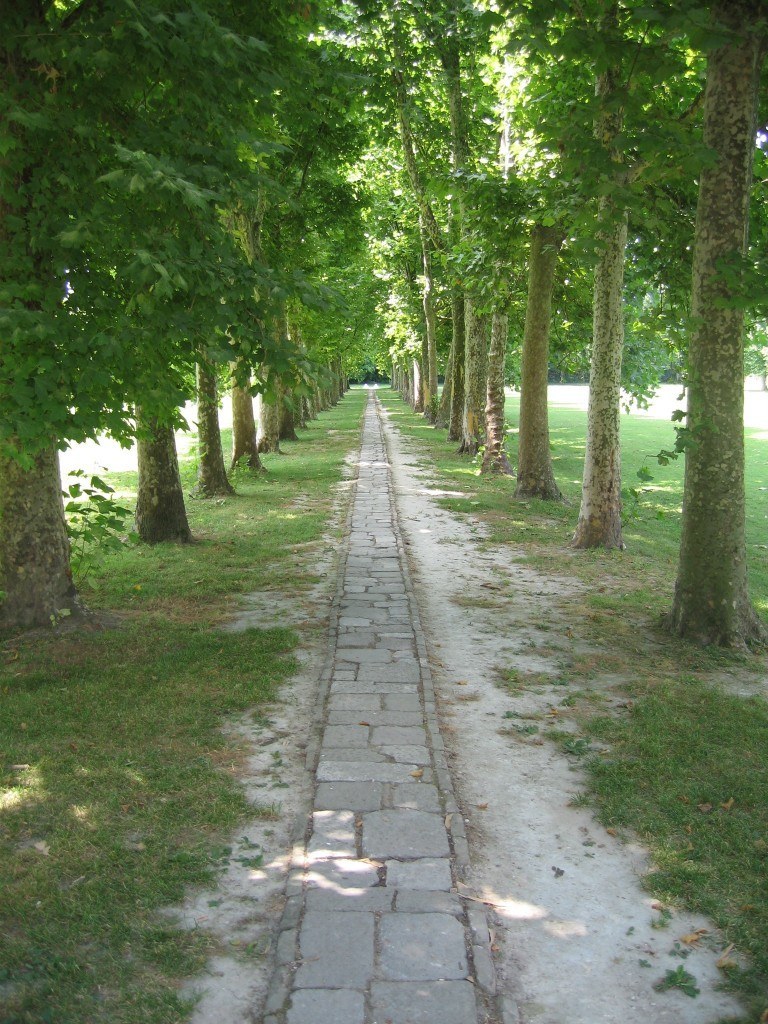
What a beautiful “ceiling” the mature canopy makes at Dumbarton Oaks below.
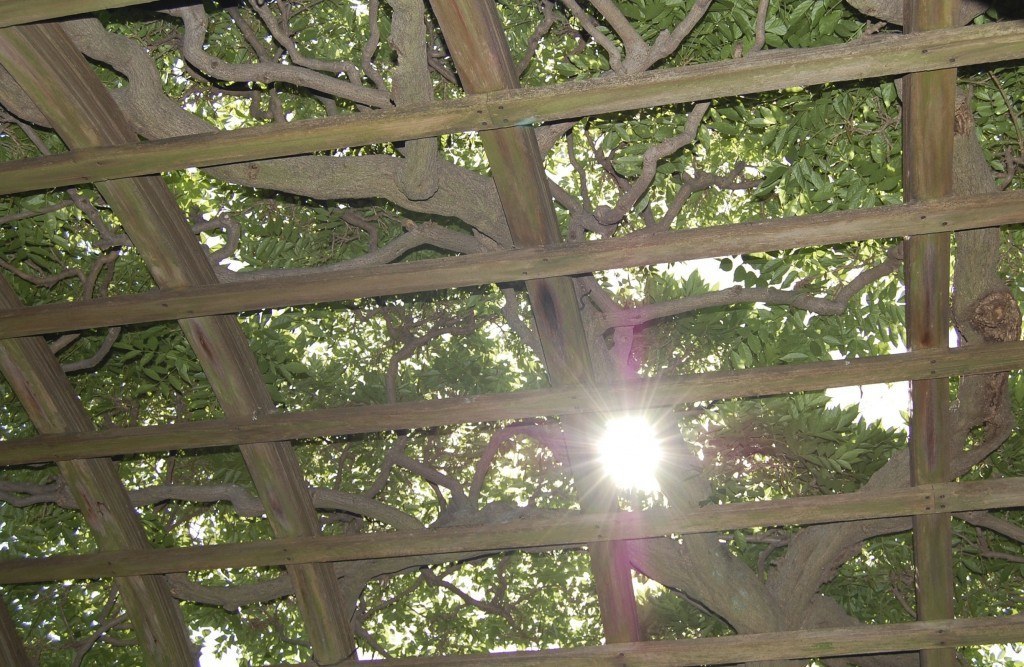
The native Sycamore (Platanus occidentalis), below, is host to a Climbing Hydrangea. Never allow English Ivy (Hedera helix) to climb a tree. When growing any other vine, be sure to keep it under control, so that the vine does not inhibit the tree from producing the leaves necessary to thrive.
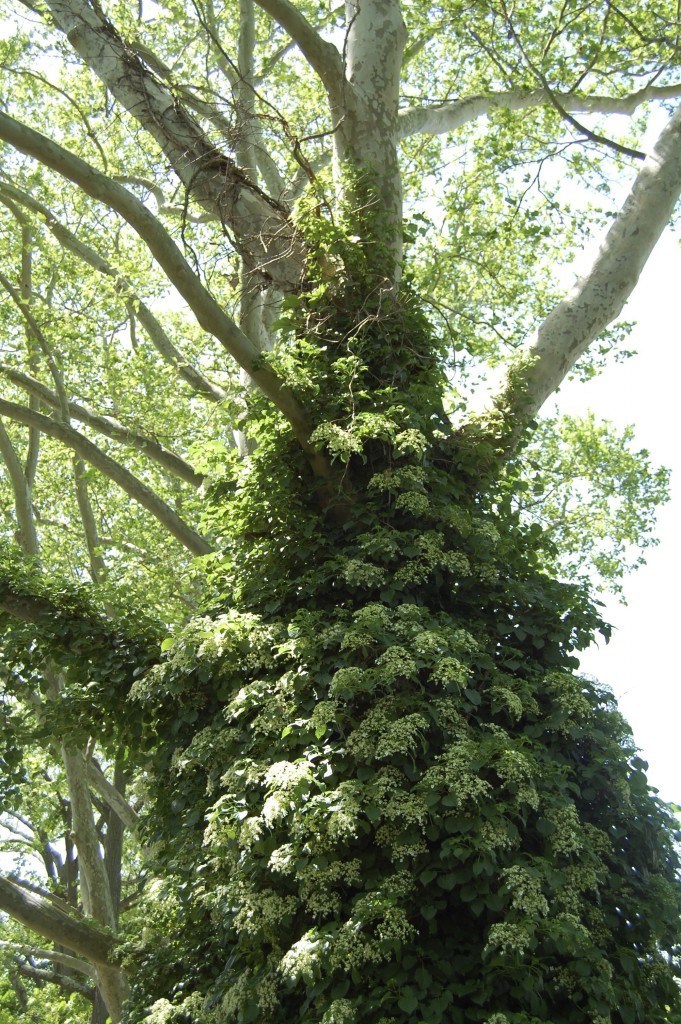
The streetscape in Savannah, below, gives me hope for urban planting. This strip bordering a commercial property was used to maximum effect. The evergreens were planted effectively between windows, then expertly pruned to frame the windows, show off the multi-trunk effect artfully against the pale wall, and allow pedestrians to pass below the canopies. They are underplanted with a simple ground cover.
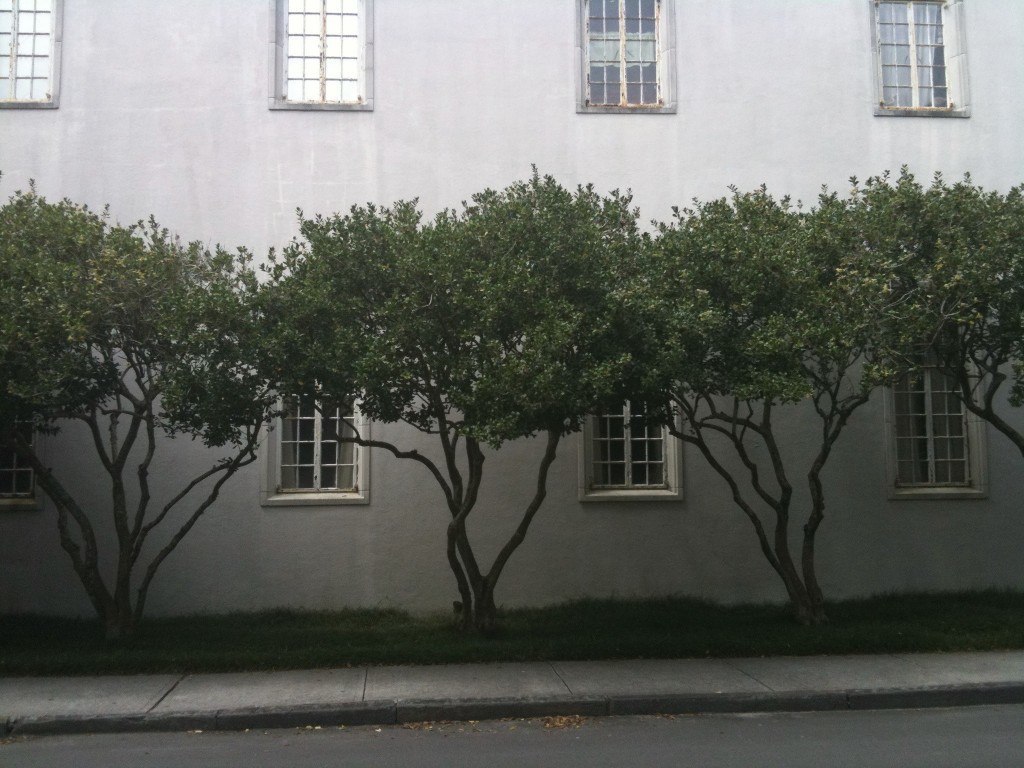
And finally, have some fun with your vertical elements, as they did in the gardens at Whilton, below!
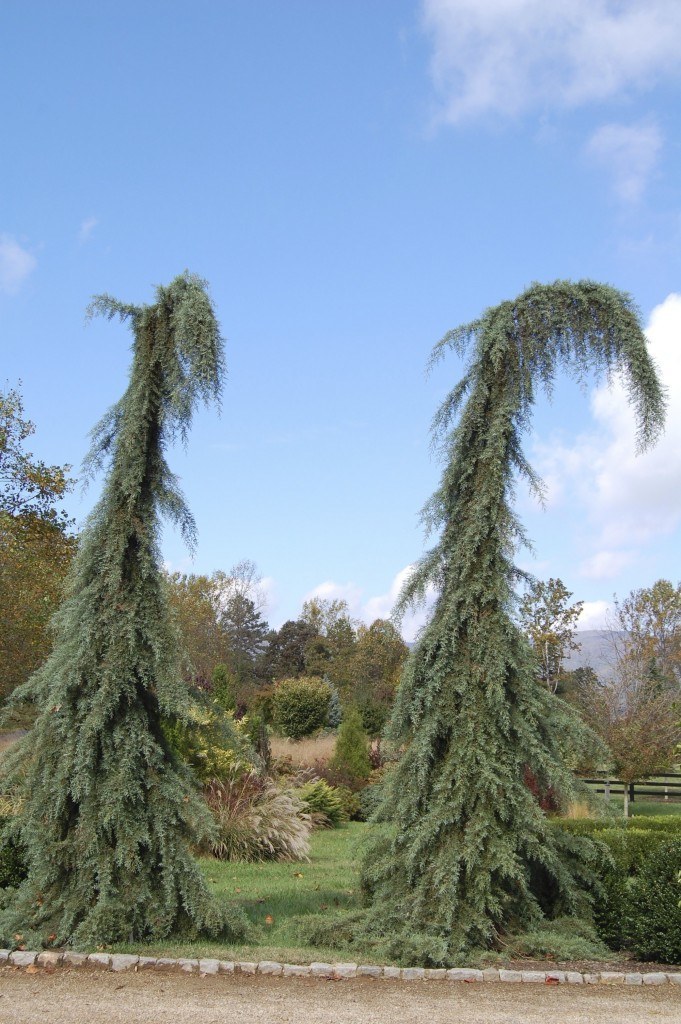
[custom-related-posts title=”Related Posts” none_text=”None found” order_by=”title” order=”ASC”]




